
CB-010 clinical program update Transformative genome-edited therapies for patients July 13, 2023
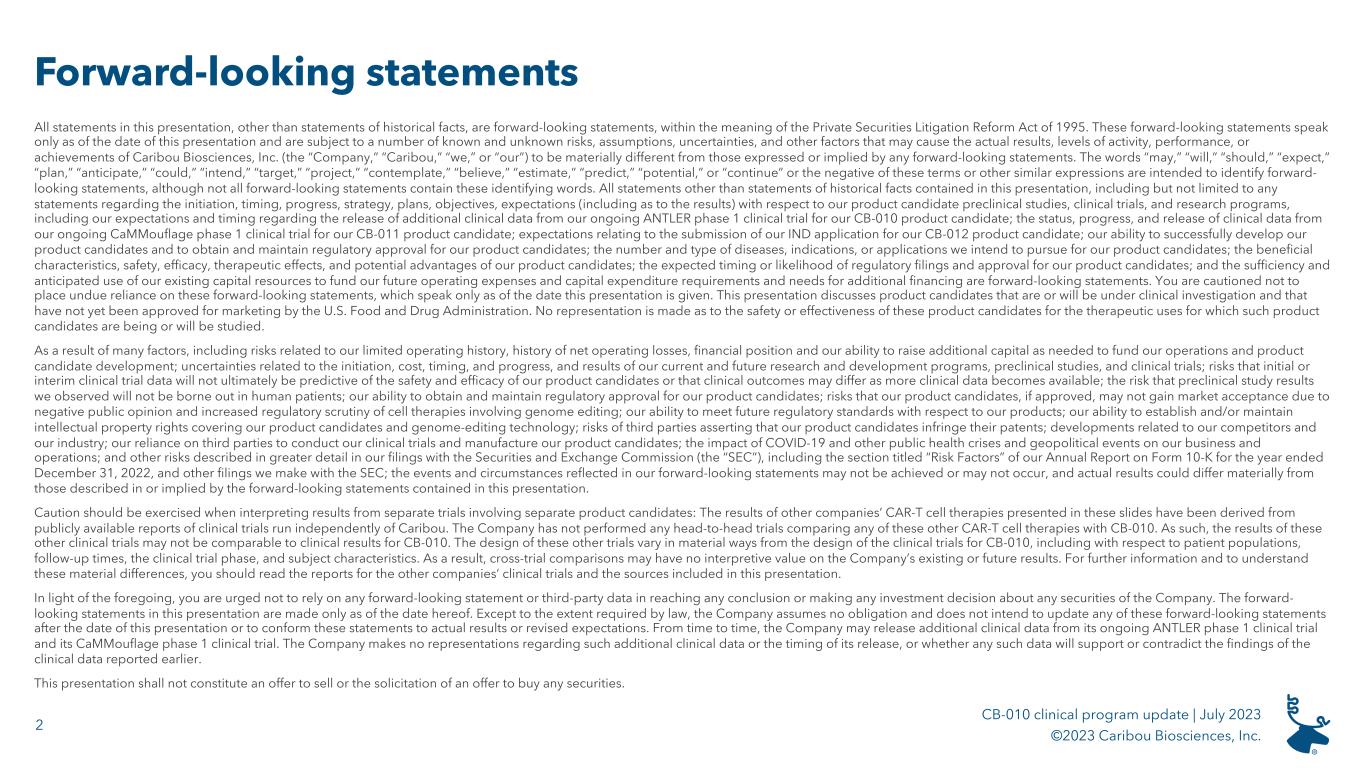
2 CB-010 clinical program update | July 2023 ©2023 Caribou Biosciences, Inc. Forward-looking statements All statements in this presentation, other than statements of historical facts, are forward-looking statements, within the meaning of the Private Securities Litigation Reform Act of 1995. These forward-looking statements speak only as of the date of this presentation and are subject to a number of known and unknown risks, assumptions, uncertainties, and other factors that may cause the actual results, levels of activity, performance, or achievements of Caribou Biosciences, Inc. (the “Company,” “Caribou,” “we,” or “our”) to be materially different from those expressed or implied by any forward-looking statements. The words “may,” “will,” “should,” “expect,” “plan,” “anticipate,” “could,” “intend,” “target,” “project,” “contemplate,” “believe,” “estimate,” “predict,” “potential,” or “continue” or the negative of these terms or other similar expressions are intended to identify forward- looking statements, although not all forward-looking statements contain these identifying words. All statements other than statements of historical facts contained in this presentation, including but not limited to any statements regarding the initiation, timing, progress, strategy, plans, objectives, expectations (including as to the results) with respect to our product candidate preclinical studies, clinical trials, and research programs, including our expectations and timing regarding the release of additional clinical data from our ongoing ANTLER phase 1 clinical trial for our CB-010 product candidate; the status, progress, and release of clinical data from our ongoing CaMMouflage phase 1 clinical trial for our CB-011 product candidate; expectations relating to the submission of our IND application for our CB-012 product candidate; our ability to successfully develop our product candidates and to obtain and maintain regulatory approval for our product candidates; the number and type of diseases, indications, or applications we intend to pursue for our product candidates; the beneficial characteristics, safety, efficacy, therapeutic effects, and potential advantages of our product candidates; the expected timing or likelihood of regulatory filings and approval for our product candidates; and the sufficiency and anticipated use of our existing capital resources to fund our future operating expenses and capital expenditure requirements and needs for additional financing are forward-looking statements. You are cautioned not to place undue reliance on these forward-looking statements, which speak only as of the date this presentation is given. This presentation discusses product candidates that are or will be under clinical investigation and that have not yet been approved for marketing by the U.S. Food and Drug Administration. No representation is made as to the safety or effectiveness of these product candidates for the therapeutic uses for which such product candidates are being or will be studied. As a result of many factors, including risks related to our limited operating history, history of net operating losses, financial position and our ability to raise additional capital as needed to fund our operations and product candidate development; uncertainties related to the initiation, cost, timing, and progress, and results of our current and future research and development programs, preclinical studies, and clinical trials; risks that initial or interim clinical trial data will not ultimately be predictive of the safety and efficacy of our product candidates or that clinical outcomes may differ as more clinical data becomes available; the risk that preclinical study results we observed will not be borne out in human patients; our ability to obtain and maintain regulatory approval for our product candidates; risks that our product candidates, if approved, may not gain market acceptance due to negative public opinion and increased regulatory scrutiny of cell therapies involving genome editing; our ability to meet future regulatory standards with respect to our products; our ability to establish and/or maintain intellectual property rights covering our product candidates and genome-editing technology; risks of third parties asserting that our product candidates infringe their patents; developments related to our competitors and our industry; our reliance on third parties to conduct our clinical trials and manufacture our product candidates; the impact of COVID-19 and other public health crises and geopolitical events on our business and operations; and other risks described in greater detail in our filings with the Securities and Exchange Commission (the “SEC”), including the section titled “Risk Factors” of our Annual Report on Form 10-K for the year ended December 31, 2022, and other filings we make with the SEC; the events and circumstances reflected in our forward-looking statements may not be achieved or may not occur, and actual results could differ materially from those described in or implied by the forward-looking statements contained in this presentation. Caution should be exercised when interpreting results from separate trials involving separate product candidates: The results of other companies’ CAR-T cell therapies presented in these slides have been derived from publicly available reports of clinical trials run independently of Caribou. The Company has not performed any head-to-head trials comparing any of these other CAR-T cell therapies with CB-010. As such, the results of these other clinical trials may not be comparable to clinical results for CB-010. The design of these other trials vary in material ways from the design of the clinical trials for CB-010, including with respect to patient populations, follow-up times, the clinical trial phase, and subject characteristics. As a result, cross-trial comparisons may have no interpretive value on the Company’s existing or future results. For further information and to understand these material differences, you should read the reports for the other companies’ clinical trials and the sources included in this presentation. In light of the foregoing, you are urged not to rely on any forward-looking statement or third-party data in reaching any conclusion or making any investment decision about any securities of the Company. The forward- looking statements in this presentation are made only as of the date hereof. Except to the extent required by law, the Company assumes no obligation and does not intend to update any of these forward-looking statements after the date of this presentation or to conform these statements to actual results or revised expectations. From time to time, the Company may release additional clinical data from its ongoing ANTLER phase 1 clinical trial and its CaMMouflage phase 1 clinical trial. The Company makes no representations regarding such additional clinical data or the timing of its release, or whether any such data will support or contradict the findings of the clinical data reported earlier. This presentation shall not constitute an offer to sell or the solicitation of an offer to buy any securities.
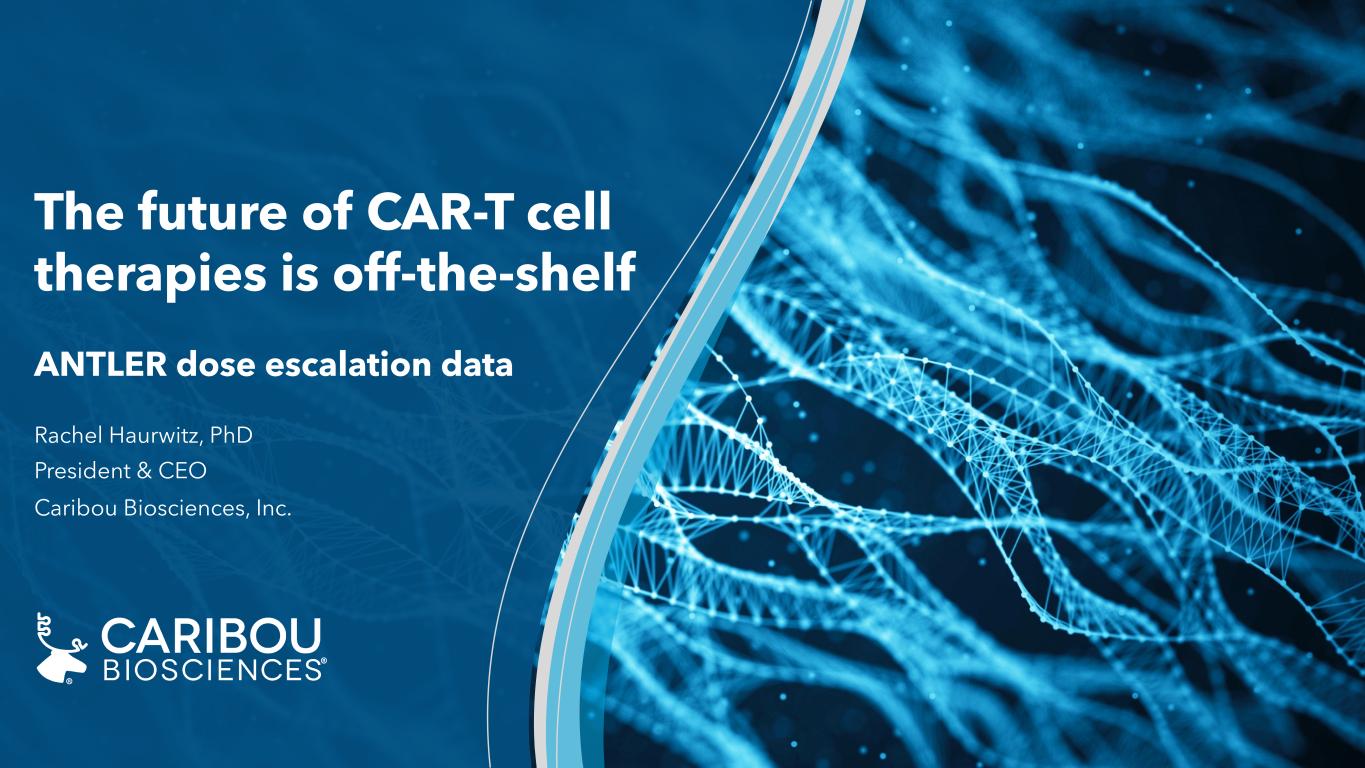
The future of CAR-T cell therapies is off-the-shelf ANTLER dose escalation data Rachel Haurwitz, PhD President & CEO Caribou Biosciences, Inc.
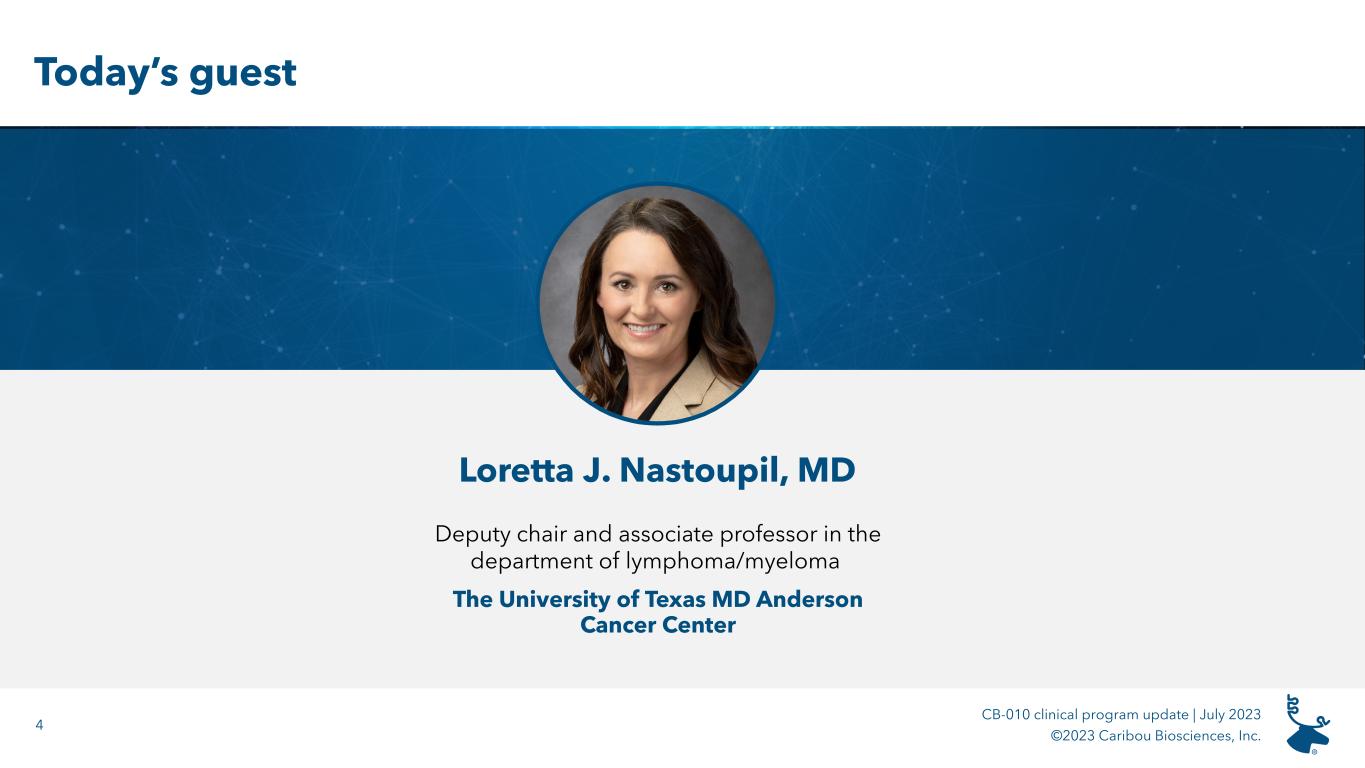
4 CB-010 clinical program update | July 2023 ©2023 Caribou Biosciences, Inc. Today’s guest Deputy chair and associate professor in the department of lymphoma/myeloma The University of Texas MD Anderson Cancer Center Loretta J. Nastoupil, MD
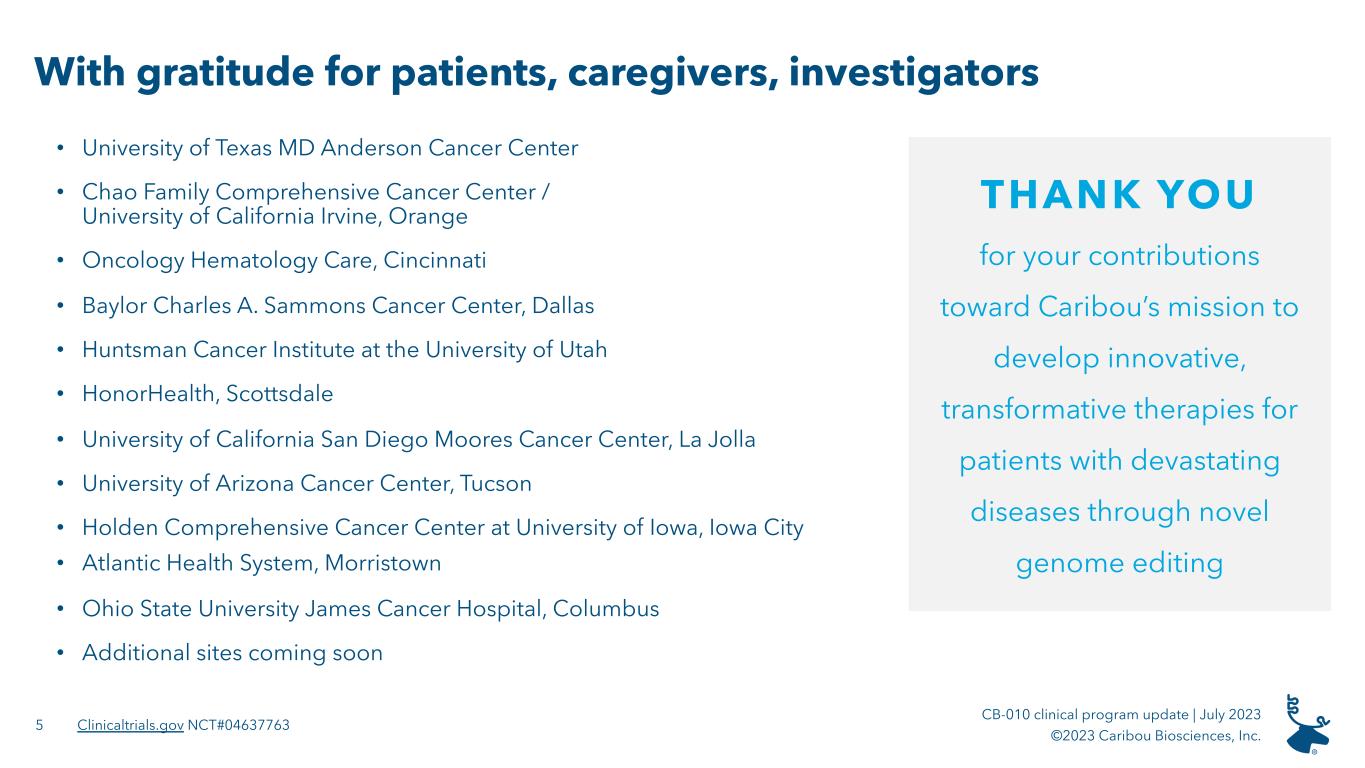
5 CB-010 clinical program update | July 2023 ©2023 Caribou Biosciences, Inc. With gratitude for patients, caregivers, investigators Clinicaltrials.gov NCT#04637763 • University of Texas MD Anderson Cancer Center • Chao Family Comprehensive Cancer Center / University of California Irvine, Orange • Oncology Hematology Care, Cincinnati • Baylor Charles A. Sammons Cancer Center, Dallas • Huntsman Cancer Institute at the University of Utah • HonorHealth, Scottsdale • University of California San Diego Moores Cancer Center, La Jolla • University of Arizona Cancer Center, Tucson • Holden Comprehensive Cancer Center at University of Iowa, Iowa City • Atlantic Health System, Morristown • Ohio State University James Cancer Hospital, Columbus • Additional sites coming soon THANK YOU for your contributions toward Caribou’s mission to develop innovative, transformative therapies for patients with devastating diseases through novel genome editing
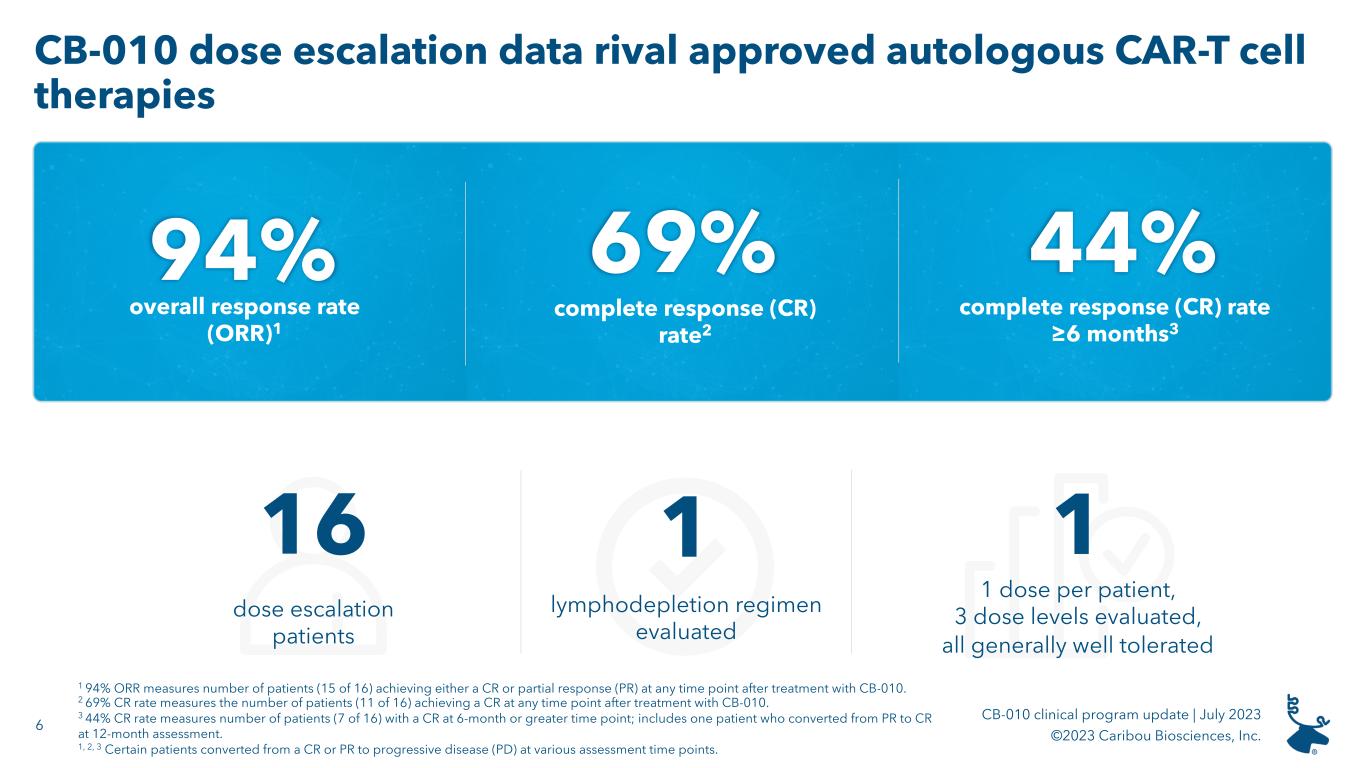
6 CB-010 clinical program update | July 2023 ©2023 Caribou Biosciences, Inc. 94% overall response rate (ORR)1 69% complete response (CR) rate2 CB-010 dose escalation data rival approved autologous CAR-T cell therapies 44% complete response (CR) rate ≥6 months3 1 94% ORR measures number of patients (15 of 16) achieving either a CR or partial response (PR) at any time point after treatment with CB-010. 2 69% CR rate measures the number of patients (11 of 16) achieving a CR at any time point after treatment with CB-010. 3 44% CR rate measures number of patients (7 of 16) with a CR at 6-month or greater time point; includes one patient who converted from PR to CR at 12-month assessment. 1, 2, 3 Certain patients converted from a CR or PR to progressive disease (PD) at various assessment time points. 1 1 dose per patient, 3 dose levels evaluated, all generally well tolerated 1 lymphodepletion regimen evaluated 16 dose escalation patients

7 CB-010 clinical program update | July 2023 ©2023 Caribou Biosciences, Inc. CB-010 drives durable CRs that rival autologous CAR-T cell therapies 94% 69% 44% 50% 32% 30% 72% 51% 36% 73% 54% 35% Overall response rate (ORR) Complete response (CR) rate CR rate at 6 months CB-010 Kymriah Yescarta Breyanzi Sources / patients enrolled Kymriah: USPI, NCT02445248, Schuster NEJM 2019 / DLBCL NOS (78%) and tFL (22%) Yescarta: USPI, NCT02348216, Focused on the Cure, Kite Pharma Corporate Presentation, March 2017 / DLBCL (76%), tFL (16%) and PMBCL (8%) Breyanzi: USPI, NCT02631044 / DLBCL NOS (53%), DLBCL transformed from indolent lymphoma (25%), HGBL (14%), PMBCL (7%) and FL grade 3B (1%) 1 ORR and CR rates shown are based on a 68 patient sub-group retrospectively identified as patients who were evaluable for the major efficacy outcome measures. 2 Enrolled population was 299; 6-month CR rate shown are patients who received treatment with Breyanzi. Phase 1 trial N=1922 Phase 1/2 trial N=101 Phase 2 trial N=1111 Phase 1 trial N=16 FOR ILLUSTRATIVE PURPOSES ONLY: The results of other CAR-T cell therapies presented on this slide have been derived from publicly available reports of clinical trials run independently of Caribou. The Company has not performed any head-to-head trials comparing any of these other CAR-T cell therapies with CB-010. As such, the results of these other clinical trials may not be comparable to clinical results for CB-010. The design of these other trials vary in material ways from the design of the clinical trials for CB-010, including with respect to patient populations, follow-up times, the clinical trial phase, and subject characteristics. As a result, cross-trial comparisons may have no interpretive value on the Company’s existing or future results. For further information and to understand these material differences, you should read the reports for the other trials at the sources included below. CB-010 CR rate at ≥6 months
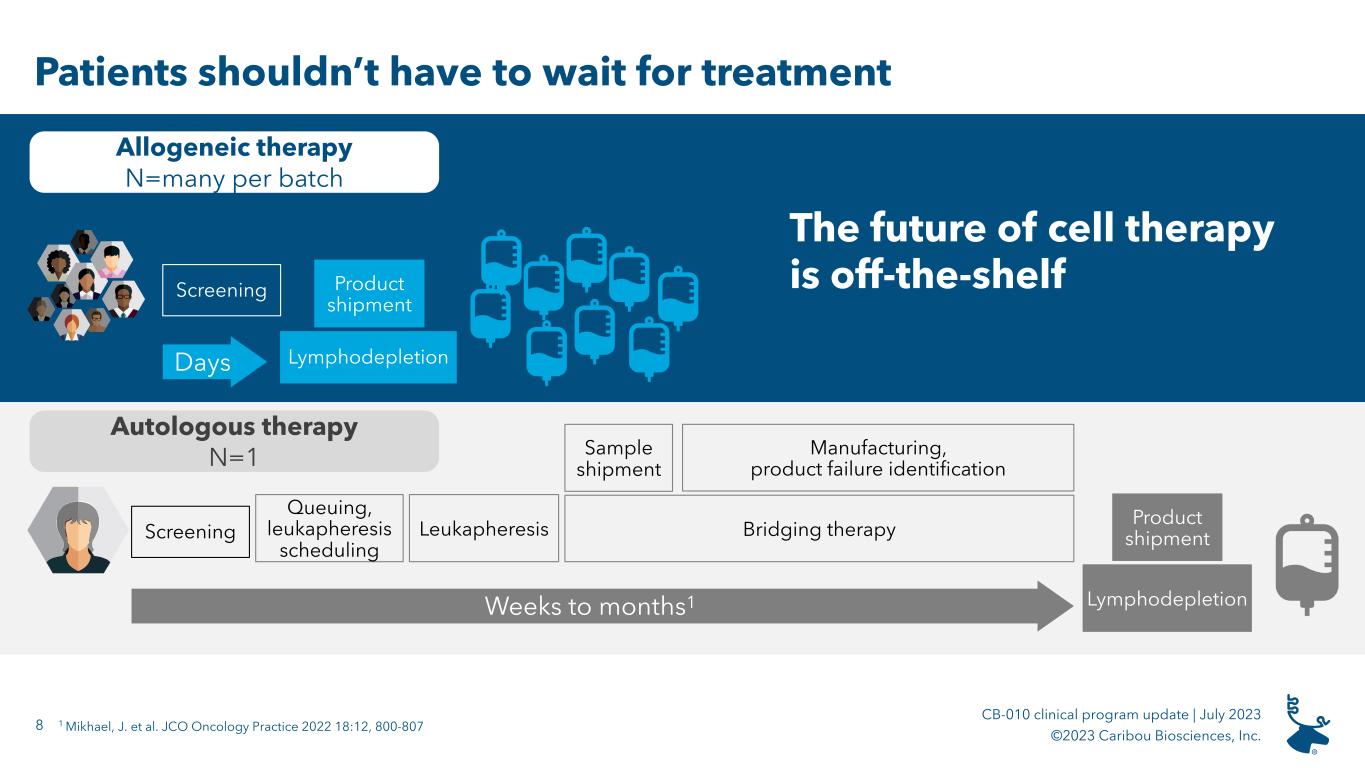
8 CB-010 clinical program update | July 2023 ©2023 Caribou Biosciences, Inc. Patients shouldn’t have to wait for treatment Autologous therapy N=1 Manufacturing, product failure identification Bridging therapyLeukapheresis Queuing, leukapheresis scheduling Sample shipment Product shipment Allogeneic therapy N=many per batch Lymphodepletion Product shipment Lymphodepletion 1 Mikhael, J. et al. JCO Oncology Practice 2022 18:12, 800-807 The future of cell therapy is off-the-shelfScreening Screening Days Weeks to months1

9 CB-010 clinical program update | July 2023 ©2023 Caribou Biosciences, Inc. Pipeline: allogeneic cell therapies targeting oncology indications IND: investigational new drug; RMAT: Regenerative Medicine Advanced Therapy 1 Phase 3 may not be required if Phase 2 is pivotal 2 Also known as CD371 3 AbbVie has an option for two additional CAR-T cell programs Program Clinical trial Target Indication Discovery IND enabling Phase 1 Phase 2 Phase 31 Designations CAR-T platform with cell therapies for hematologic indications CB-010 ANTLER dose expansion CD19 r/r B-NHL RMAT, Fast Track, Orphan Drug CB-011 CaMMouflage dose escalation BCMA r/r MM Fast Track CB-012 IND application planned CLL-12 r/r AML CAR-NK platform with iPSC-derived cell therapies for solid tumor indications CB-020 ROR1 solid tumors AbbVie programs under collaboration agreement3 CAR-T program 1 undisclosed CAR-T program 2 undisclosed
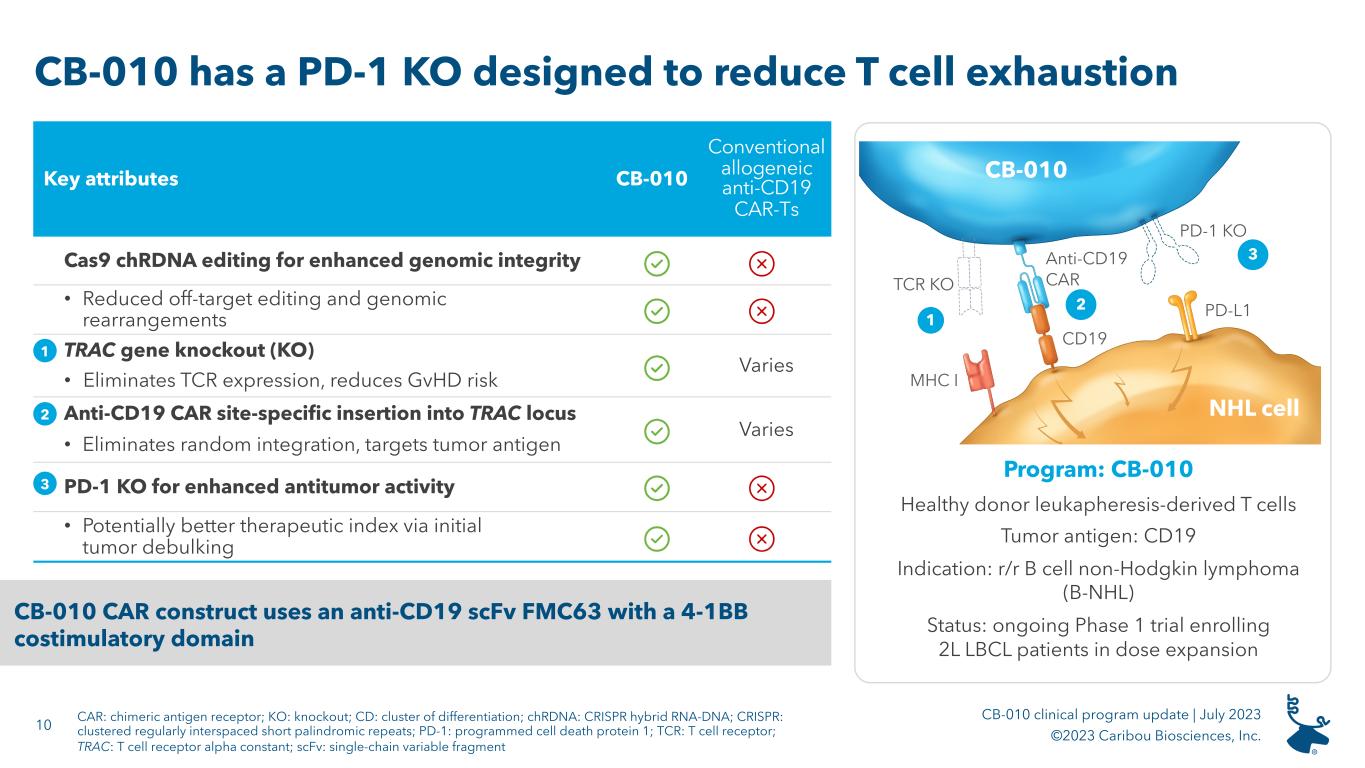
10 CB-010 clinical program update | July 2023 ©2023 Caribou Biosciences, Inc. CB-010 has a PD-1 KO designed to reduce T cell exhaustion CAR: chimeric antigen receptor; KO: knockout; CD: cluster of differentiation; chRDNA: CRISPR hybrid RNA-DNA; CRISPR: clustered regularly interspaced short palindromic repeats; PD-1: programmed cell death protein 1; TCR: T cell receptor; TRAC: T cell receptor alpha constant; scFv: single-chain variable fragment CB-010 NHL cell 1 2 3 TCR KO MHC I Anti-CD19 CAR CD19 PD-L1 PD-1 KO CB-010 CAR construct uses an anti-CD19 scFv FMC63 with a 4-1BB costimulatory domain Key attributes CB-010 Conventional allogeneic anti-CD19 CAR-Ts Cas9 chRDNA editing for enhanced genomic integrity • Reduced off-target editing and genomic rearrangements TRAC gene knockout (KO) • Eliminates TCR expression, reduces GvHD risk Varies Anti-CD19 CAR site-specific insertion into TRAC locus • Eliminates random integration, targets tumor antigen Varies PD-1 KO for enhanced antitumor activity • Potentially better therapeutic index via initial tumor debulking 1 2 3 Program: CB-010 Healthy donor leukapheresis-derived T cells Tumor antigen: CD19 Indication: r/r B cell non-Hodgkin lymphoma (B-NHL) Status: ongoing Phase 1 trial enrolling 2L LBCL patients in dose expansion
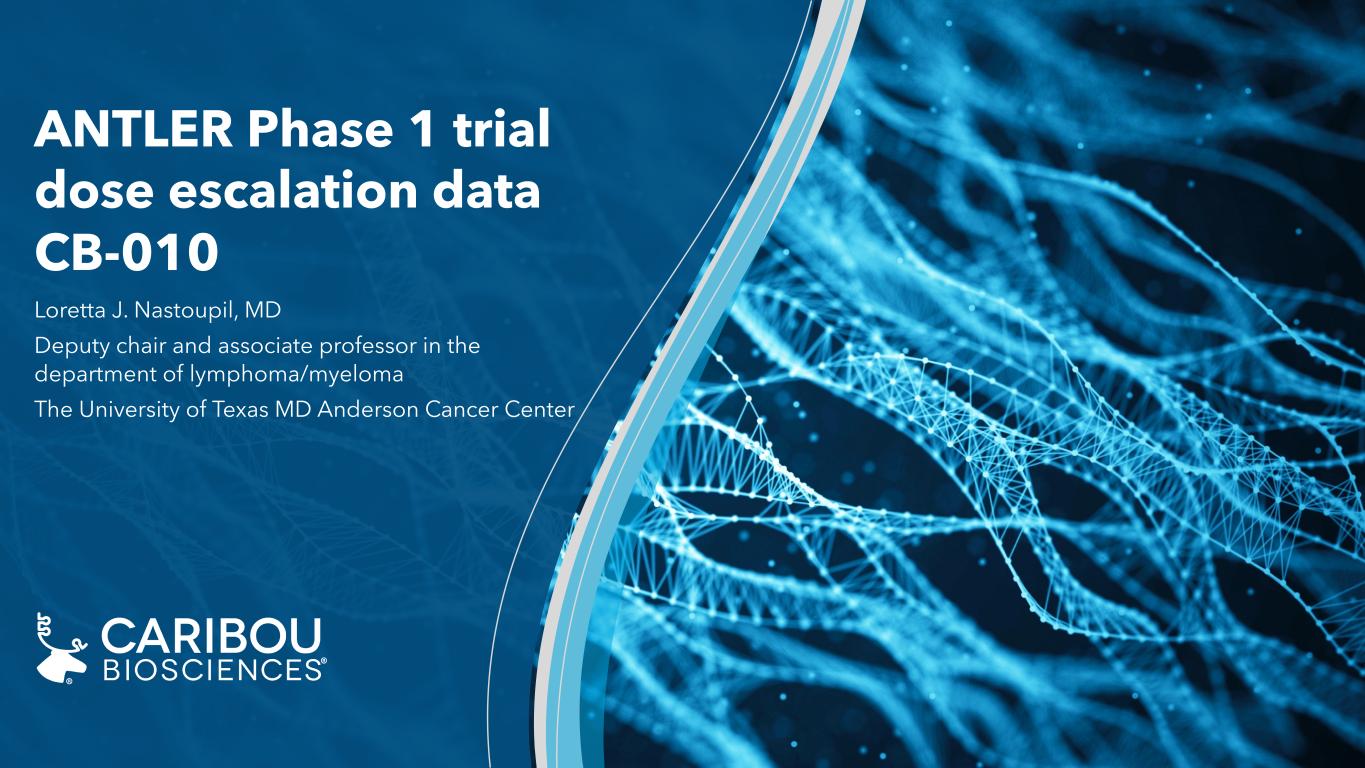
ANTLER Phase 1 trial dose escalation data CB-010 Loretta J. Nastoupil, MD Deputy chair and associate professor in the department of lymphoma/myeloma The University of Texas MD Anderson Cancer Center
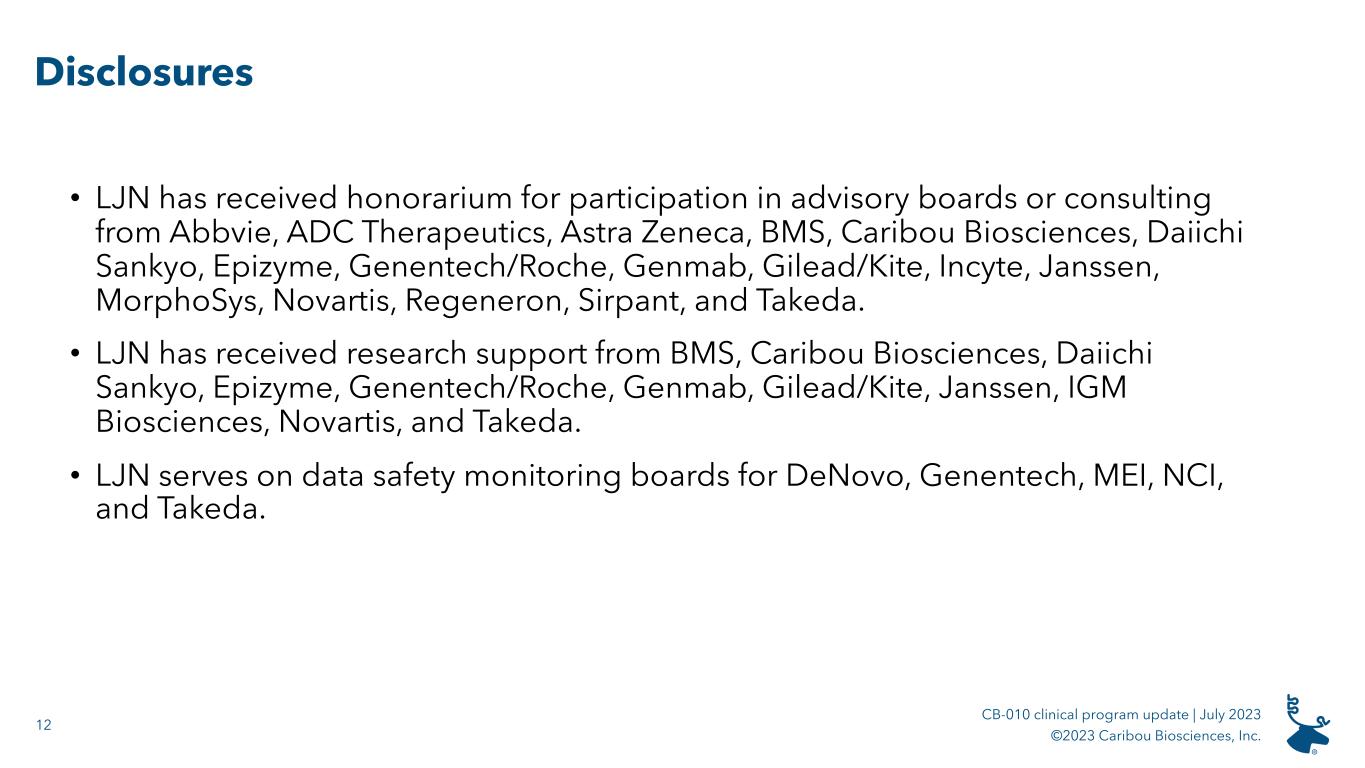
12 CB-010 clinical program update | July 2023 ©2023 Caribou Biosciences, Inc. Disclosures • LJN has received honorarium for participation in advisory boards or consulting from Abbvie, ADC Therapeutics, Astra Zeneca, BMS, Caribou Biosciences, Daiichi Sankyo, Epizyme, Genentech/Roche, Genmab, Gilead/Kite, Incyte, Janssen, MorphoSys, Novartis, Regeneron, Sirpant, and Takeda. • LJN has received research support from BMS, Caribou Biosciences, Daiichi Sankyo, Epizyme, Genentech/Roche, Genmab, Gilead/Kite, Janssen, IGM Biosciences, Novartis, and Takeda. • LJN serves on data safety monitoring boards for DeNovo, Genentech, MEI, NCI, and Takeda.
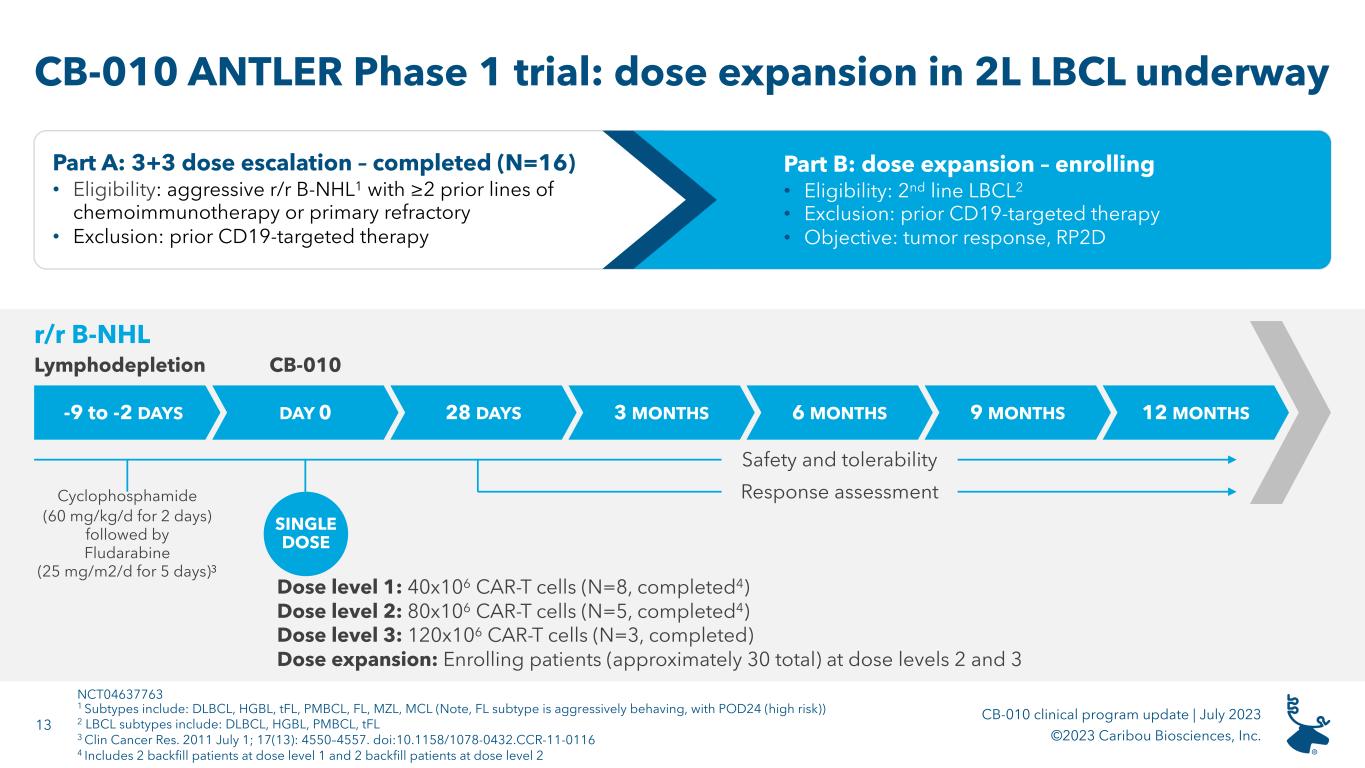
13 CB-010 clinical program update | July 2023 ©2023 Caribou Biosciences, Inc. CB-010 ANTLER Phase 1 trial: dose expansion in 2L LBCL underway NCT04637763 1 Subtypes include: DLBCL, HGBL, tFL, PMBCL, FL, MZL, MCL (Note, FL subtype is aggressively behaving, with POD24 (high risk)) 2 LBCL subtypes include: DLBCL, HGBL, PMBCL, tFL 3 Clin Cancer Res. 2011 July 1; 17(13): 4550–4557. doi:10.1158/1078-0432.CCR-11-0116 4 Includes 2 backfill patients at dose level 1 and 2 backfill patients at dose level 2 Part A: 3+3 dose escalation – completed (N=16) • Eligibility: aggressive r/r B-NHL1 with ≥2 prior lines of chemoimmunotherapy or primary refractory • Exclusion: prior CD19-targeted therapy -9 to -2 DAYS DAY 0 28 DAYS 3 MONTHS 6 MONTHS 9 MONTHS 12 MONTHS r/r B-NHL Lymphodepletion Part B: dose expansion – enrolling • Eligibility: 2nd line LBCL2 • Exclusion: prior CD19-targeted therapy • Objective: tumor response, RP2D CB-010 Safety and tolerability Response assessmentCyclophosphamide (60 mg/kg/d for 2 days) followed by Fludarabine (25 mg/m2/d for 5 days)3 SINGLE DOSE Dose level 1: 40x106 CAR-T cells (N=8, completed4) Dose level 2: 80x106 CAR-T cells (N=5, completed4) Dose level 3: 120x106 CAR-T cells (N=3, completed) Dose expansion: Enrolling patients (approximately 30 total) at dose levels 2 and 3
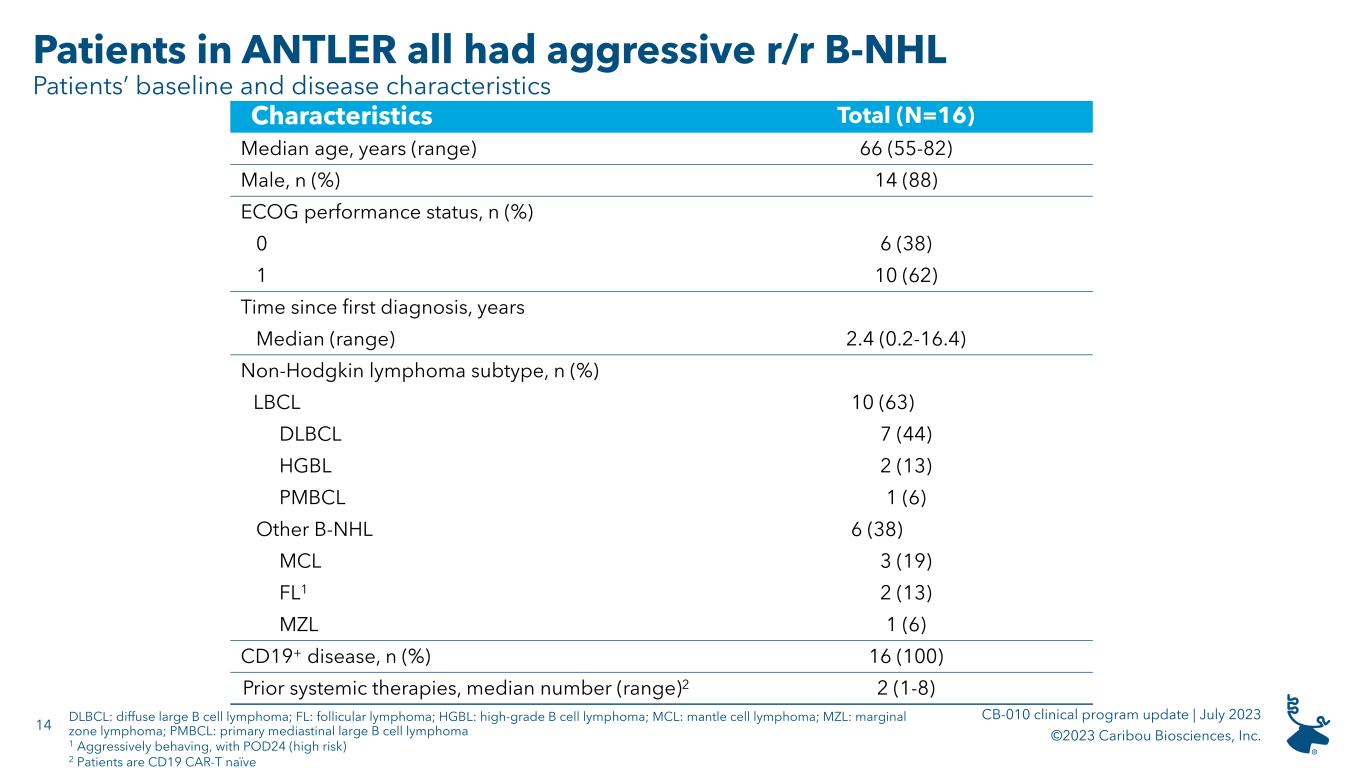
14 CB-010 clinical program update | July 2023 ©2023 Caribou Biosciences, Inc. Patients in ANTLER all had aggressive r/r B-NHL Patients’ baseline and disease characteristics DLBCL: diffuse large B cell lymphoma; FL: follicular lymphoma; HGBL: high-grade B cell lymphoma; MCL: mantle cell lymphoma; MZL: marginal zone lymphoma; PMBCL: primary mediastinal large B cell lymphoma 1 Aggressively behaving, with POD24 (high risk) 2 Patients are CD19 CAR-T naïve Characteristics Total (N=16) Median age, years (range) 66 (55-82) Male, n (%) 14 (88) ECOG performance status, n (%) 0 6 (38) 1 10 (62) Time since first diagnosis, years Median (range) 2.4 (0.2-16.4) Non-Hodgkin lymphoma subtype, n (%) LBCL 10 (63) DLBCL 7 (44) HGBL 2 (13) PMBCL 1 (6) Other B-NHL 6 (38) MCL 3 (19) FL1 2 (13) MZL 1 (6) CD19+ disease, n (%) 16 (100) Prior systemic therapies, median number (range)2 2 (1-8)
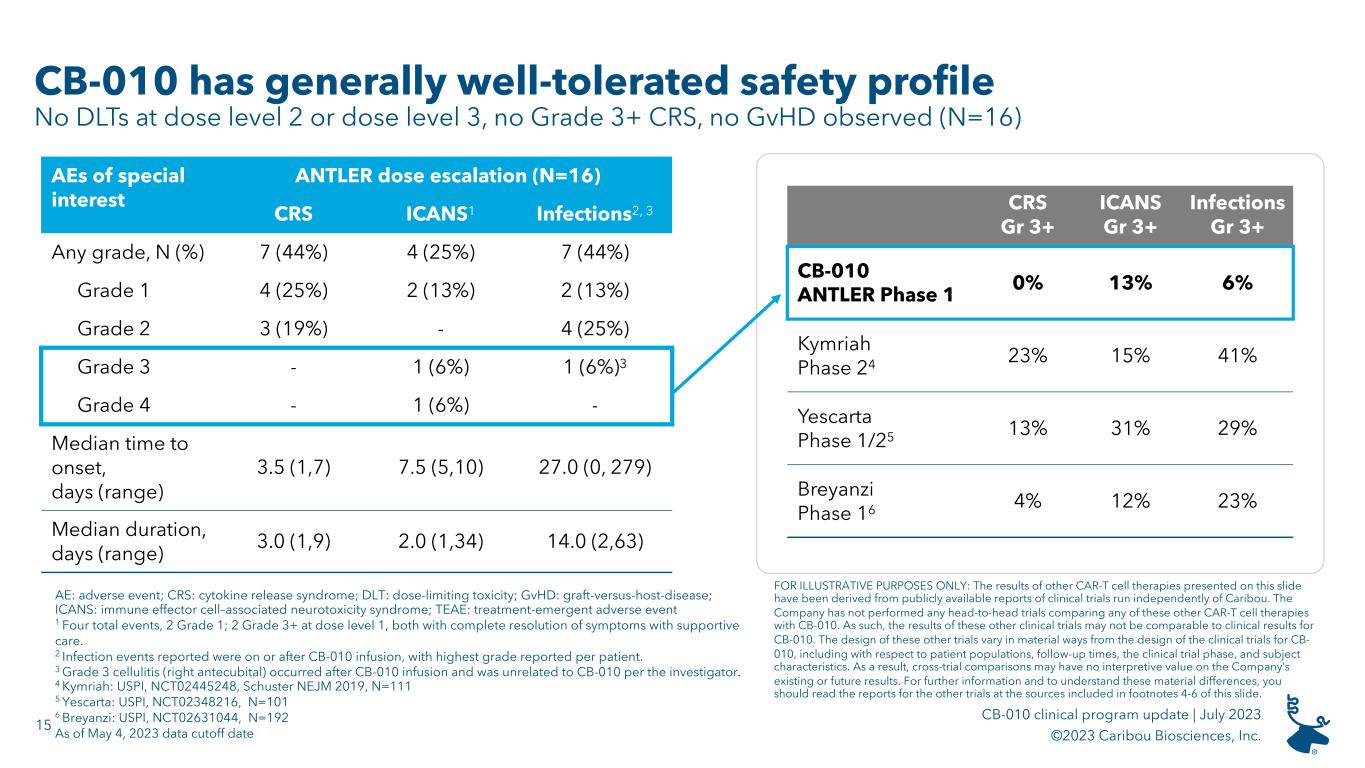
15 CB-010 clinical program update | July 2023 ©2023 Caribou Biosciences, Inc. CB-010 has generally well-tolerated safety profile No DLTs at dose level 2 or dose level 3, no Grade 3+ CRS, no GvHD observed (N=16) AE: adverse event; CRS: cytokine release syndrome; DLT: dose-limiting toxicity; GvHD: graft-versus-host-disease; ICANS: immune effector cell–associated neurotoxicity syndrome; TEAE: treatment-emergent adverse event 1 Four total events, 2 Grade 1; 2 Grade 3+ at dose level 1, both with complete resolution of symptoms with supportive care. 2 Infection events reported were on or after CB-010 infusion, with highest grade reported per patient. 3 Grade 3 cellulitis (right antecubital) occurred after CB-010 infusion and was unrelated to CB-010 per the investigator. 4 Kymriah: USPI, NCT02445248, Schuster NEJM 2019, N=111 5 Yescarta: USPI, NCT02348216, N=101 6 Breyanzi: USPI, NCT02631044, N=192 As of May 4, 2023 data cutoff date AEs of special interest ANTLER dose escalation (N=16) CRS ICANS1 Infections2, 3 Any grade, N (%) 7 (44%) 4 (25%) 7 (44%) Grade 1 4 (25%) 2 (13%) 2 (13%) Grade 2 3 (19%) - 4 (25%) Grade 3 - 1 (6%) 1 (6%)3 Grade 4 - 1 (6%) - Median time to onset, days (range) 3.5 (1,7) 7.5 (5,10) 27.0 (0, 279) Median duration, days (range) 3.0 (1,9) 2.0 (1,34) 14.0 (2,63) CRS Gr 3+ ICANS Gr 3+ Infections Gr 3+ CB-010 ANTLER Phase 1 0% 13% 6% Kymriah Phase 24 23% 15% 41% Yescarta Phase 1/25 13% 31% 29% Breyanzi Phase 16 4% 12% 23% FOR ILLUSTRATIVE PURPOSES ONLY: The results of other CAR-T cell therapies presented on this slide have been derived from publicly available reports of clinical trials run independently of Caribou. The Company has not performed any head-to-head trials comparing any of these other CAR-T cell therapies with CB-010. As such, the results of these other clinical trials may not be comparable to clinical results for CB-010. The design of these other trials vary in material ways from the design of the clinical trials for CB- 010, including with respect to patient populations, follow-up times, the clinical trial phase, and subject characteristics. As a result, cross-trial comparisons may have no interpretive value on the Company’s existing or future results. For further information and to understand these material differences, you should read the reports for the other trials at the sources included in footnotes 4-6 of this slide.

16 CB-010 clinical program update | July 2023 ©2023 Caribou Biosciences, Inc. DLBCL: diffuse large B cell lymphoma; FL: follicular lymphoma; HGBL: high-grade B cell lymphoma; MCL: mantle cell lymphoma; MZL: marginal zone lymphoma; PMBCL: primary mediastinal large B cell lymphoma 1 Aggressively behaving, with POD24 (high risk) 2 Primary refractory disease 3 Patient 5’s 3-month scan conducted on day 63 post CB-010 as per investigator’s discretion 4 Patients 13-16 are backfill patients at 40M and 80M 5 Certain patients converted from a CR or PR to PD at various assessment time points as indicated in the chart above CB-010 ANTLER dose escalation efficacy assessment Overall depth and duration of response 1 2 3 Months from CB-010 infusion 4 12 Subtype Dose Prior # Rx Best Resp. Pt # FL1 40M 8 CR 1 DLBCL 40M 4 CR 4 DLBCL2 80M 1 CR 7 DLBCL2 80M 1 CR 8 PMBCL3 40M 2 CR 5 MCL 40M 2 CR 134 DLBCL 80M 2 CR 9 MZL 80M 4 PR 154 MCL 40M 4 CR 2 FL1 40M 2 CR 3 DLBCL 40M 2 CR 6 DLBCL 120M 2 CR 10 HGBL2 40M 1 PR 144 MCL 80M 2 PR 164 HGBL2 120M 1 PR 12 DLBCL 120M 2 SD 11 9 15 6-month benchmark 24 SINGLE CB-010 DOSE CR: complete response PR: partial response SD: stable disease PD: progressive disease Overall r/r B-NHL 94% ORR5 in patients treated with CB-010 across all dose levels (15 of 16) 69% (11 of 16) achieved a CR5 • 44% (7 of 16) had ≥6-month CR5 • 24 months longest CR to date As of June 20, 2023, data collection ongoing, efficacy based on Lugano criteria 5 18 216 ////////// //
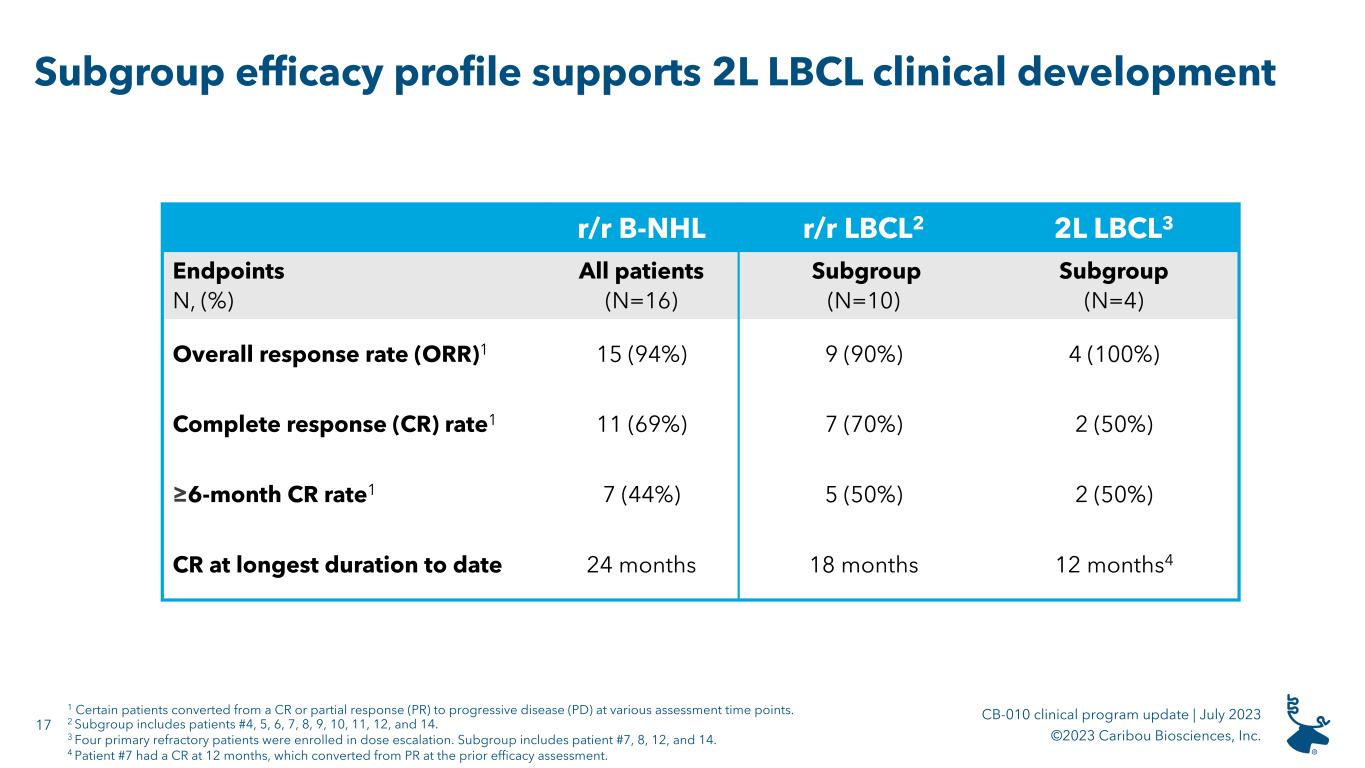
17 CB-010 clinical program update | July 2023 ©2023 Caribou Biosciences, Inc. Subgroup efficacy profile supports 2L LBCL clinical development r/r B-NHL r/r LBCL2 2L LBCL3 Endpoints N, (%) All patients (N=16) Subgroup (N=10) Subgroup (N=4) Overall response rate (ORR)1 15 (94%) 9 (90%) 4 (100%) Complete response (CR) rate1 11 (69%) 7 (70%) 2 (50%) ≥6-month CR rate1 7 (44%) 5 (50%) 2 (50%) CR at longest duration to date 24 months 18 months 12 months4 1 Certain patients converted from a CR or partial response (PR) to progressive disease (PD) at various assessment time points. 2 Subgroup includes patients #4, 5, 6, 7, 8, 9, 10, 11, 12, and 14. 3 Four primary refractory patients were enrolled in dose escalation. Subgroup includes patient #7, 8, 12, and 14. 4 Patient #7 had a CR at 12 months, which converted from PR at the prior efficacy assessment.
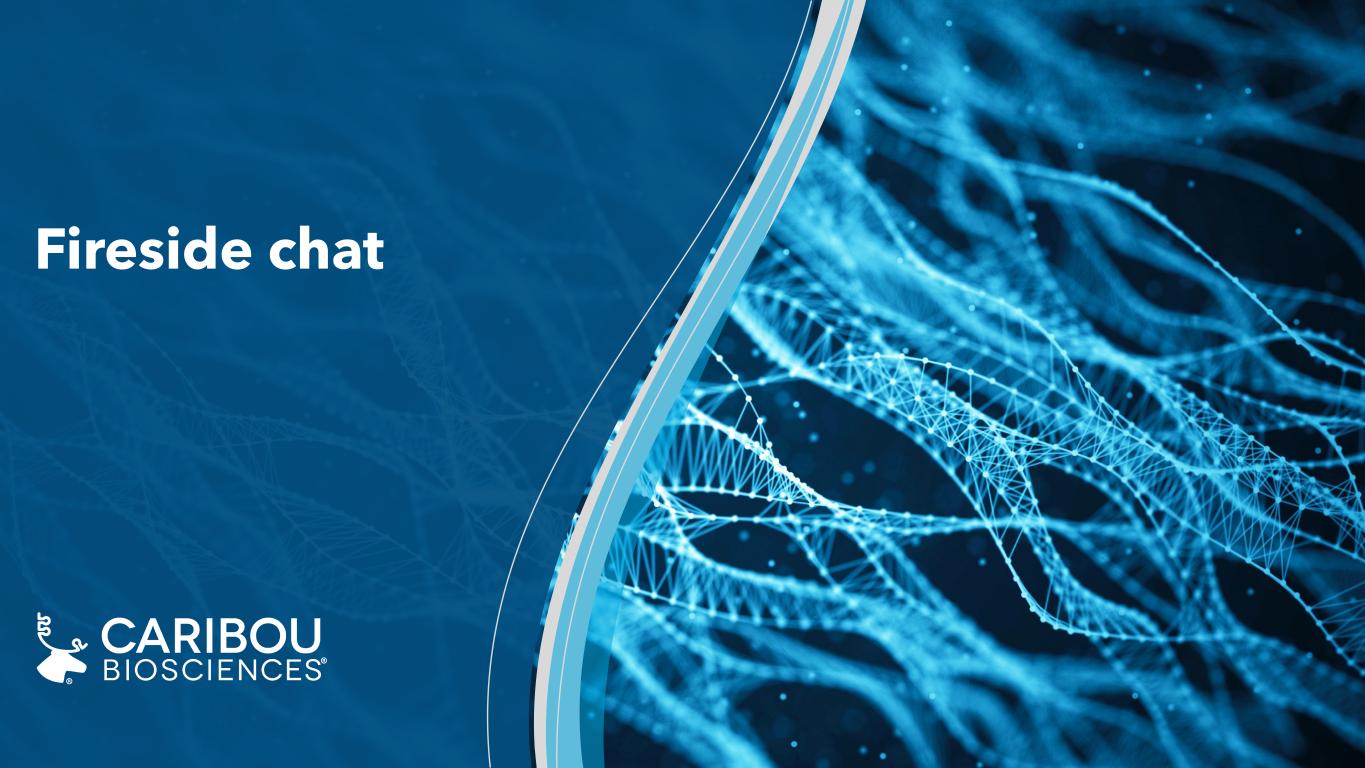
Fireside chat
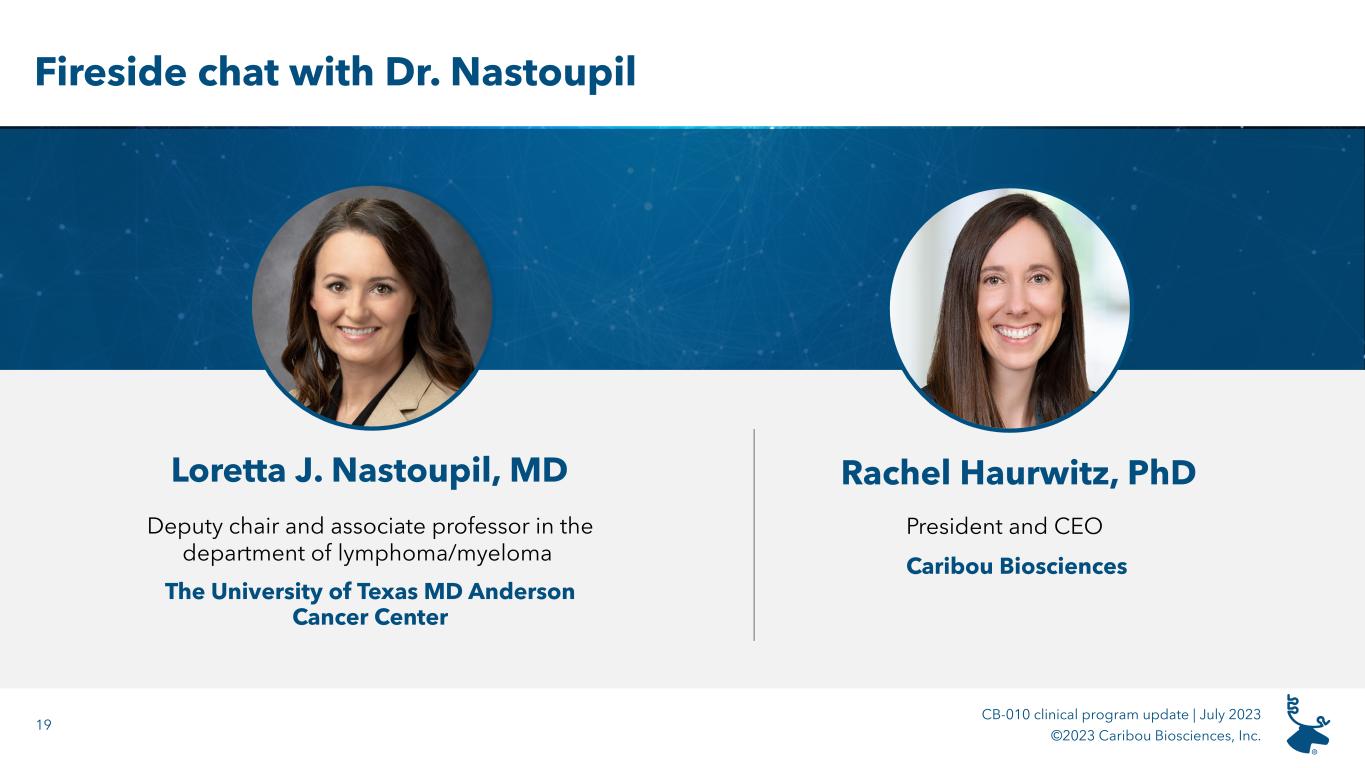
19 CB-010 clinical program update | July 2023 ©2023 Caribou Biosciences, Inc. Fireside chat with Dr. Nastoupil President and CEO Caribou Biosciences Rachel Haurwitz, PhD Deputy chair and associate professor in the department of lymphoma/myeloma The University of Texas MD Anderson Cancer Center Loretta J. Nastoupil, MD
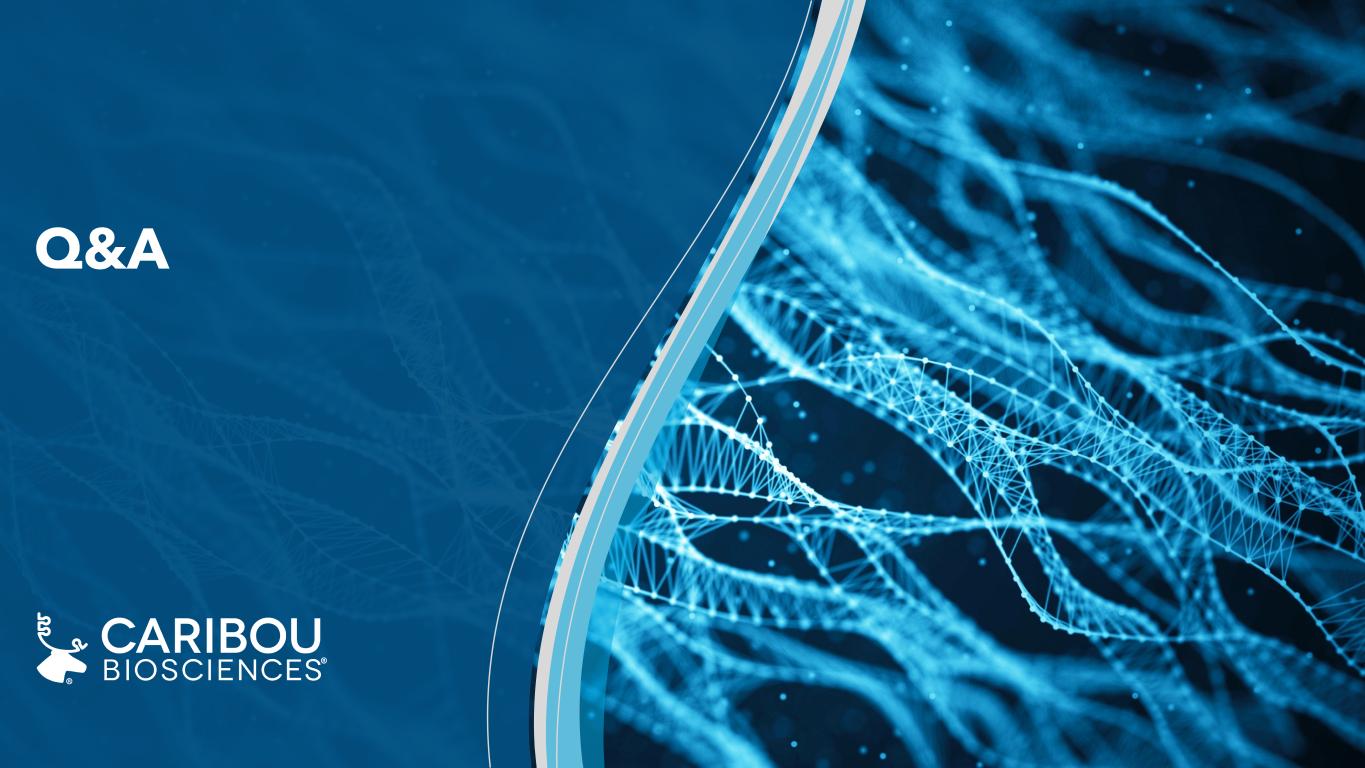
Q&A

21 CB-010 clinical program update | July 2023 ©2023 Caribou Biosciences, Inc. Open to your questions President and CEO Rachel Haurwitz, PhD CMO Syed Rizvi, MD Caribou Biosciences Steve Kanner, PhD CSO Loretta J. Nastoupil, MD Deputy chair and associate professor in the department of lymphoma/myeloma The University of Texas MD Anderson Cancer Center
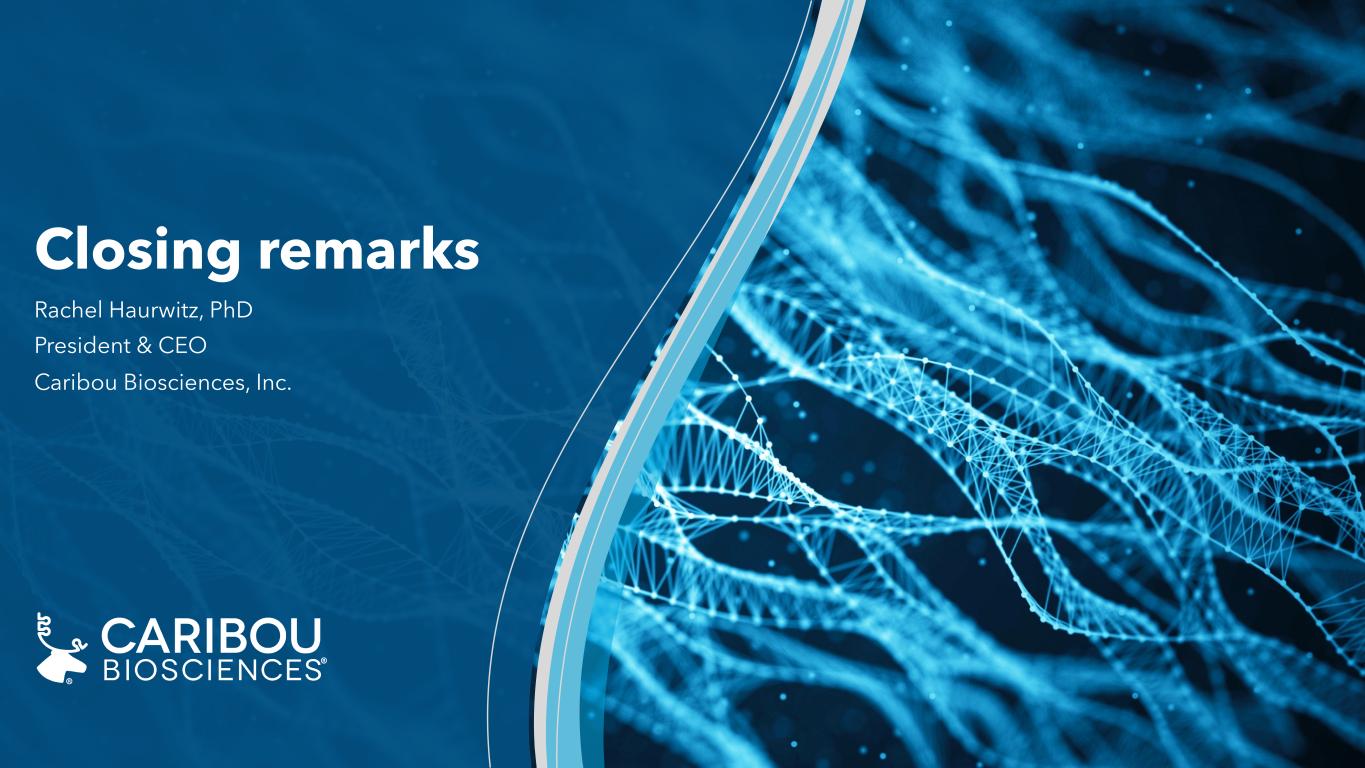
Closing remarks Rachel Haurwitz, PhD President & CEO Caribou Biosciences, Inc.
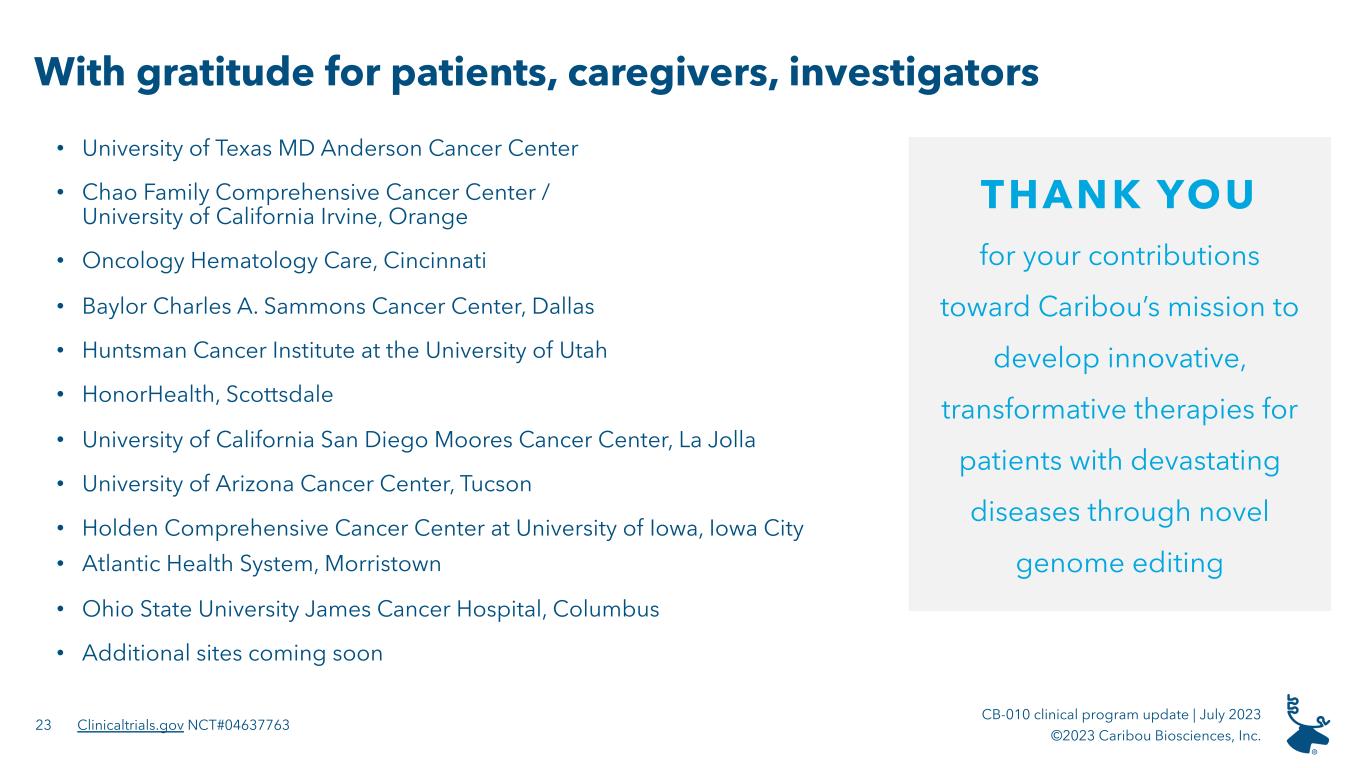
23 CB-010 clinical program update | July 2023 ©2023 Caribou Biosciences, Inc. With gratitude for patients, caregivers, investigators Clinicaltrials.gov NCT#04637763 • University of Texas MD Anderson Cancer Center • Chao Family Comprehensive Cancer Center / University of California Irvine, Orange • Oncology Hematology Care, Cincinnati • Baylor Charles A. Sammons Cancer Center, Dallas • Huntsman Cancer Institute at the University of Utah • HonorHealth, Scottsdale • University of California San Diego Moores Cancer Center, La Jolla • University of Arizona Cancer Center, Tucson • Holden Comprehensive Cancer Center at University of Iowa, Iowa City • Atlantic Health System, Morristown • Ohio State University James Cancer Hospital, Columbus • Additional sites coming soon THANK YOU for your contributions toward Caribou’s mission to develop innovative, transformative therapies for patients with devastating diseases through novel genome editing
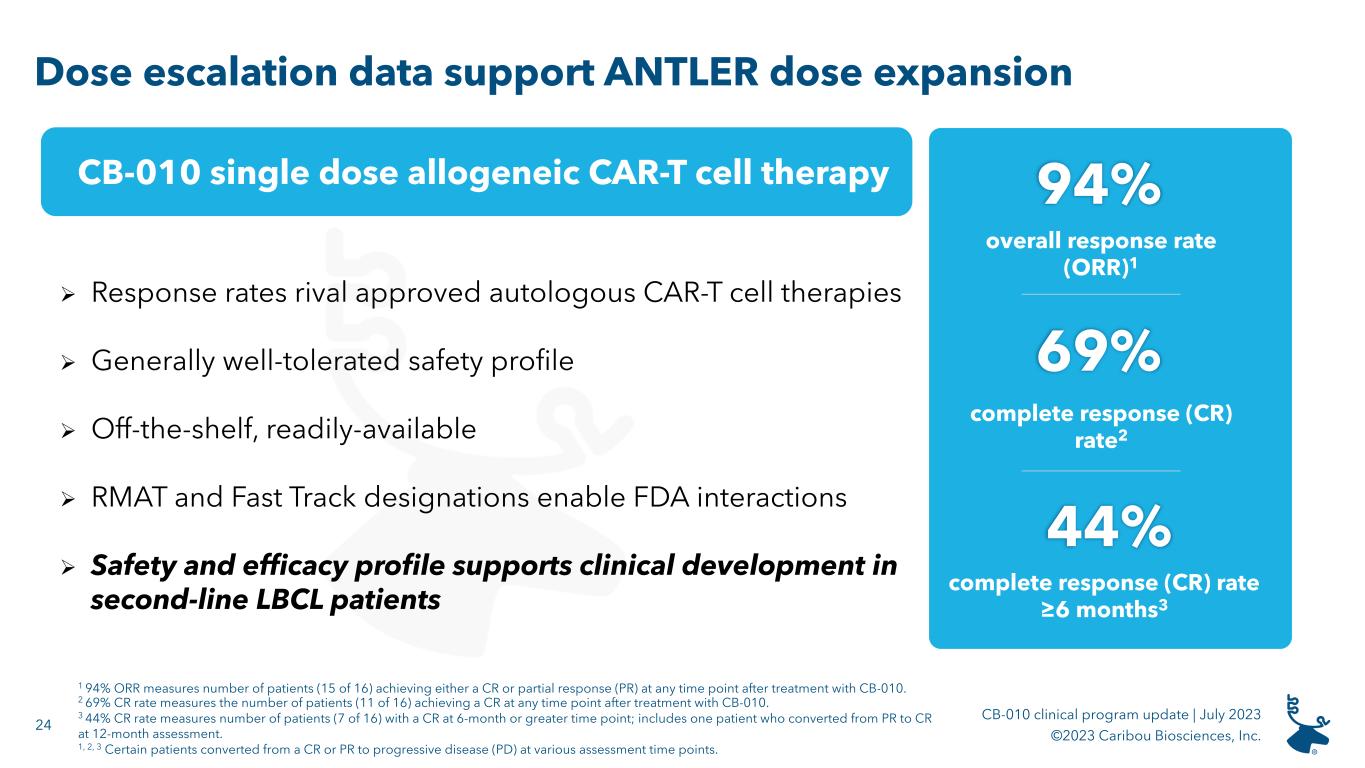
24 CB-010 clinical program update | July 2023 ©2023 Caribou Biosciences, Inc. Dose escalation data support ANTLER dose expansion 1 94% ORR measures number of patients (15 of 16) achieving either a CR or partial response (PR) at any time point after treatment with CB-010. 2 69% CR rate measures the number of patients (11 of 16) achieving a CR at any time point after treatment with CB-010. 3 44% CR rate measures number of patients (7 of 16) with a CR at 6-month or greater time point; includes one patient who converted from PR to CR at 12-month assessment. 1, 2, 3 Certain patients converted from a CR or PR to progressive disease (PD) at various assessment time points. 94% overall response rate (ORR)1 69% complete response (CR) rate2 44% complete response (CR) rate ≥6 months3 Ø Response rates rival approved autologous CAR-T cell therapies Ø Generally well-tolerated safety profile Ø Off-the-shelf, readily-available Ø RMAT and Fast Track designations enable FDA interactions Ø Safety and efficacy profile supports clinical development in second-line LBCL patients CB-010 single dose allogeneic CAR-T cell therapy
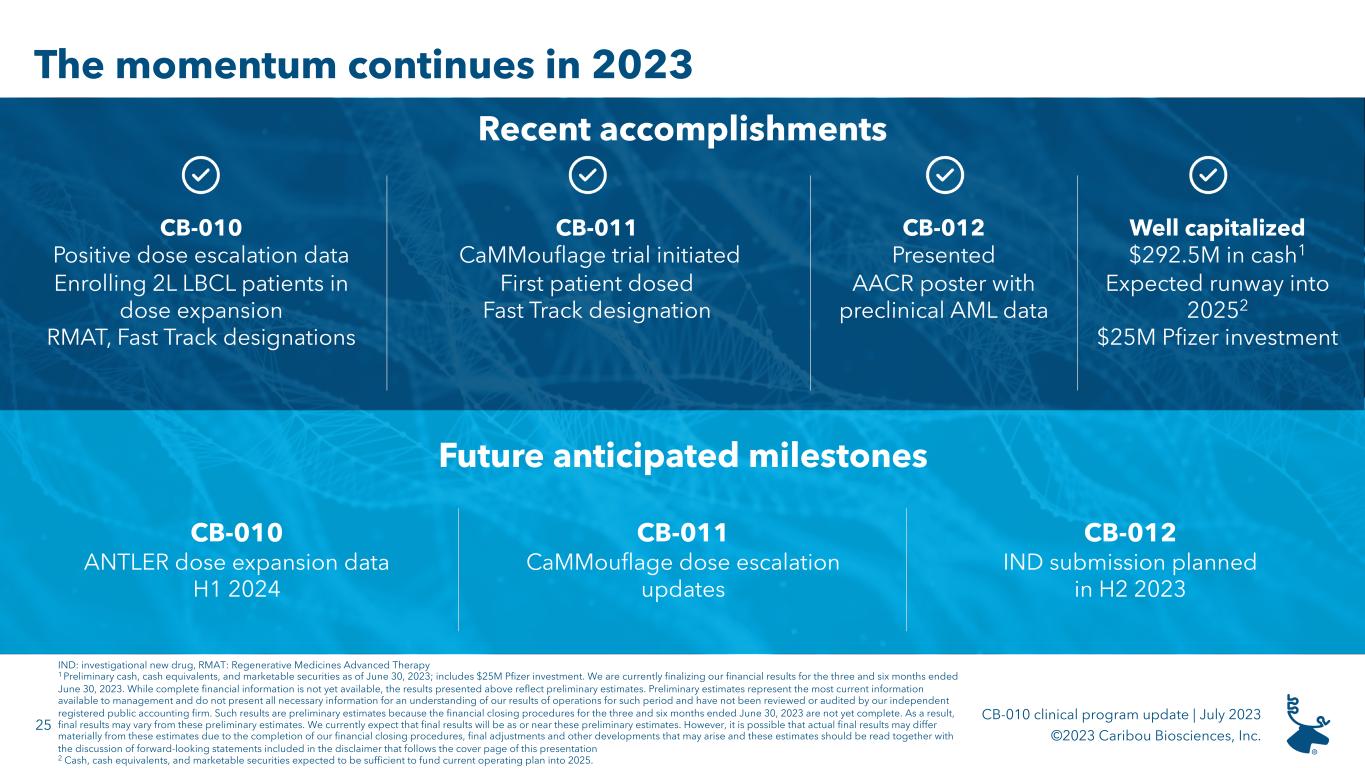
25 CB-010 clinical program update | July 2023 ©2023 Caribou Biosciences, Inc. The momentum continues in 2023 IND: investigational new drug, RMAT: Regenerative Medicines Advanced Therapy 1 Preliminary cash, cash equivalents, and marketable securities as of June 30, 2023; includes $25M Pfizer investment. We are currently finalizing our financial results for the three and six months ended June 30, 2023. While complete financial information is not yet available, the results presented above reflect preliminary estimates. Preliminary estimates represent the most current information available to management and do not present all necessary information for an understanding of our results of operations for such period and have not been reviewed or audited by our independent registered public accounting firm. Such results are preliminary estimates because the financial closing procedures for the three and six months ended June 30, 2023 are not yet complete. As a result, final results may vary from these preliminary estimates. We currently expect that final results will be as or near these preliminary estimates. However, it is possible that actual final results may differ materially from these estimates due to the completion of our financial closing procedures, final adjustments and other developments that may arise and these estimates should be read together with the discussion of forward-looking statements included in the disclaimer that follows the cover page of this presentation 2 Cash, cash equivalents, and marketable securities expected to be sufficient to fund current operating plan into 2025. Future anticipated milestones CB-011 CaMMouflage dose escalation updates CB-010 ANTLER dose expansion data H1 2024 CB-012 IND submission planned in H2 2023 Recent accomplishments CB-011 CaMMouflage trial initiated First patient dosed Fast Track designation CB-010 Positive dose escalation data Enrolling 2L LBCL patients in dose expansion RMAT, Fast Track designations Well capitalized $292.5M in cash1 Expected runway into 20252 $25M Pfizer investment CB-012 Presented AACR poster with preclinical AML data

Thank you https://cariboubio.com info@cariboubio.com

Appendix
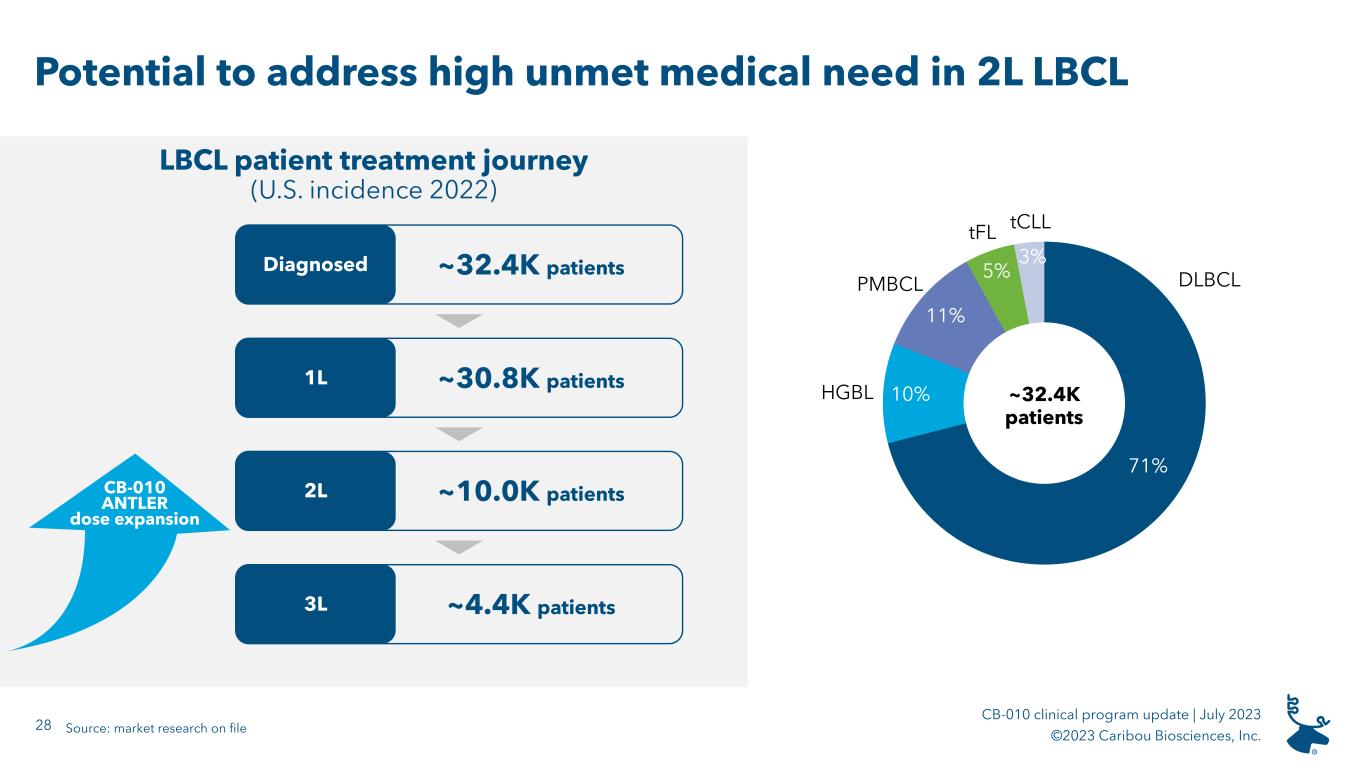
28 CB-010 clinical program update | July 2023 ©2023 Caribou Biosciences, Inc. Potential to address high unmet medical need in 2L LBCL 71% 10% 11% 5% HGBL PMBCL tFL 3% tCLL ~32.4K patients DLBCL ~32.4K patientsDiagnosed 1L ~30.8K patients 2L ~10.0K patients 3L ~4.4K patients LBCL patient treatment journey (U.S. incidence 2022) Source: market research on file CB-010 ANTLER dose expansion
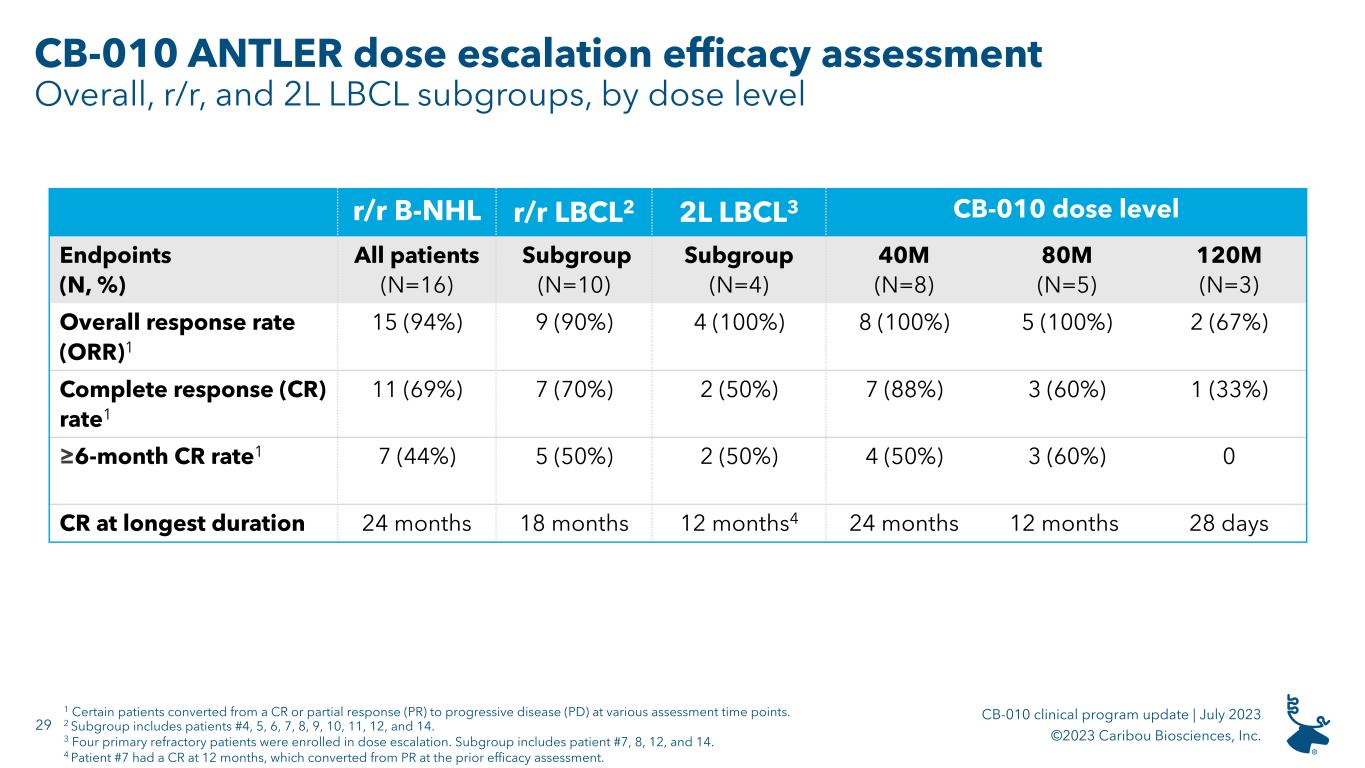
29 CB-010 clinical program update | July 2023 ©2023 Caribou Biosciences, Inc. CB-010 ANTLER dose escalation efficacy assessment Overall, r/r, and 2L LBCL subgroups, by dose level 1 Certain patients converted from a CR or partial response (PR) to progressive disease (PD) at various assessment time points. 2 Subgroup includes patients #4, 5, 6, 7, 8, 9, 10, 11, 12, and 14. 3 Four primary refractory patients were enrolled in dose escalation. Subgroup includes patient #7, 8, 12, and 14. 4 Patient #7 had a CR at 12 months, which converted from PR at the prior efficacy assessment. r/r B-NHL r/r LBCL2 2L LBCL3 CB-010 dose level Endpoints (N, %) All patients (N=16) Subgroup (N=10) Subgroup (N=4) 40M (N=8) 80M (N=5) 120M (N=3) Overall response rate (ORR)1 15 (94%) 9 (90%) 4 (100%) 8 (100%) 5 (100%) 2 (67%) Complete response (CR) rate1 11 (69%) 7 (70%) 2 (50%) 7 (88%) 3 (60%) 1 (33%) ≥6-month CR rate1 7 (44%) 5 (50%) 2 (50%) 4 (50%) 3 (60%) 0 CR at longest duration 24 months 18 months 12 months4 24 months 12 months 28 days
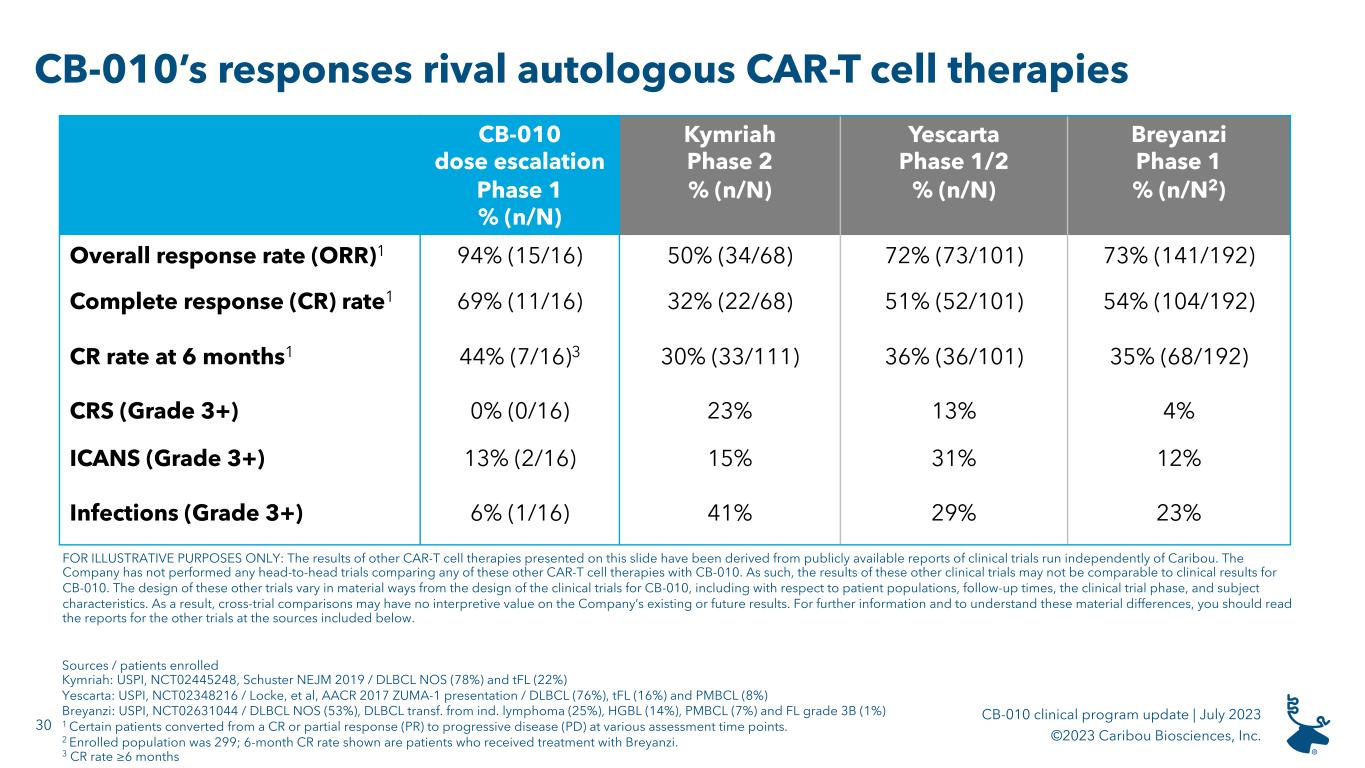
30 CB-010 clinical program update | July 2023 ©2023 Caribou Biosciences, Inc. CB-010’s responses rival autologous CAR-T cell therapies Sources / patients enrolled Kymriah: USPI, NCT02445248, Schuster NEJM 2019 / DLBCL NOS (78%) and tFL (22%) Yescarta: USPI, NCT02348216 / Locke, et al, AACR 2017 ZUMA-1 presentation / DLBCL (76%), tFL (16%) and PMBCL (8%) Breyanzi: USPI, NCT02631044 / DLBCL NOS (53%), DLBCL transf. from ind. lymphoma (25%), HGBL (14%), PMBCL (7%) and FL grade 3B (1%) 1 Certain patients converted from a CR or partial response (PR) to progressive disease (PD) at various assessment time points. 2 Enrolled population was 299; 6-month CR rate shown are patients who received treatment with Breyanzi. 3 CR rate ≥6 months CB-010 dose escalation Phase 1 % (n/N) Kymriah Phase 2 % (n/N) Yescarta Phase 1/2 % (n/N) Breyanzi Phase 1 % (n/N2) Overall response rate (ORR)1 94% (15/16) 50% (34/68) 72% (73/101) 73% (141/192) Complete response (CR) rate1 69% (11/16) 32% (22/68) 51% (52/101) 54% (104/192) CR rate at 6 months1 44% (7/16)3 30% (33/111) 36% (36/101) 35% (68/192) CRS (Grade 3+) 0% (0/16) 23% 13% 4% ICANS (Grade 3+) 13% (2/16) 15% 31% 12% Infections (Grade 3+) 6% (1/16) 41% 29% 23% FOR ILLUSTRATIVE PURPOSES ONLY: The results of other CAR-T cell therapies presented on this slide have been derived from publicly available reports of clinical trials run independently of Caribou. The Company has not performed any head-to-head trials comparing any of these other CAR-T cell therapies with CB-010. As such, the results of these other clinical trials may not be comparable to clinical results for CB-010. The design of these other trials vary in material ways from the design of the clinical trials for CB-010, including with respect to patient populations, follow-up times, the clinical trial phase, and subject characteristics. As a result, cross-trial comparisons may have no interpretive value on the Company’s existing or future results. For further information and to understand these material differences, you should read the reports for the other trials at the sources included below.
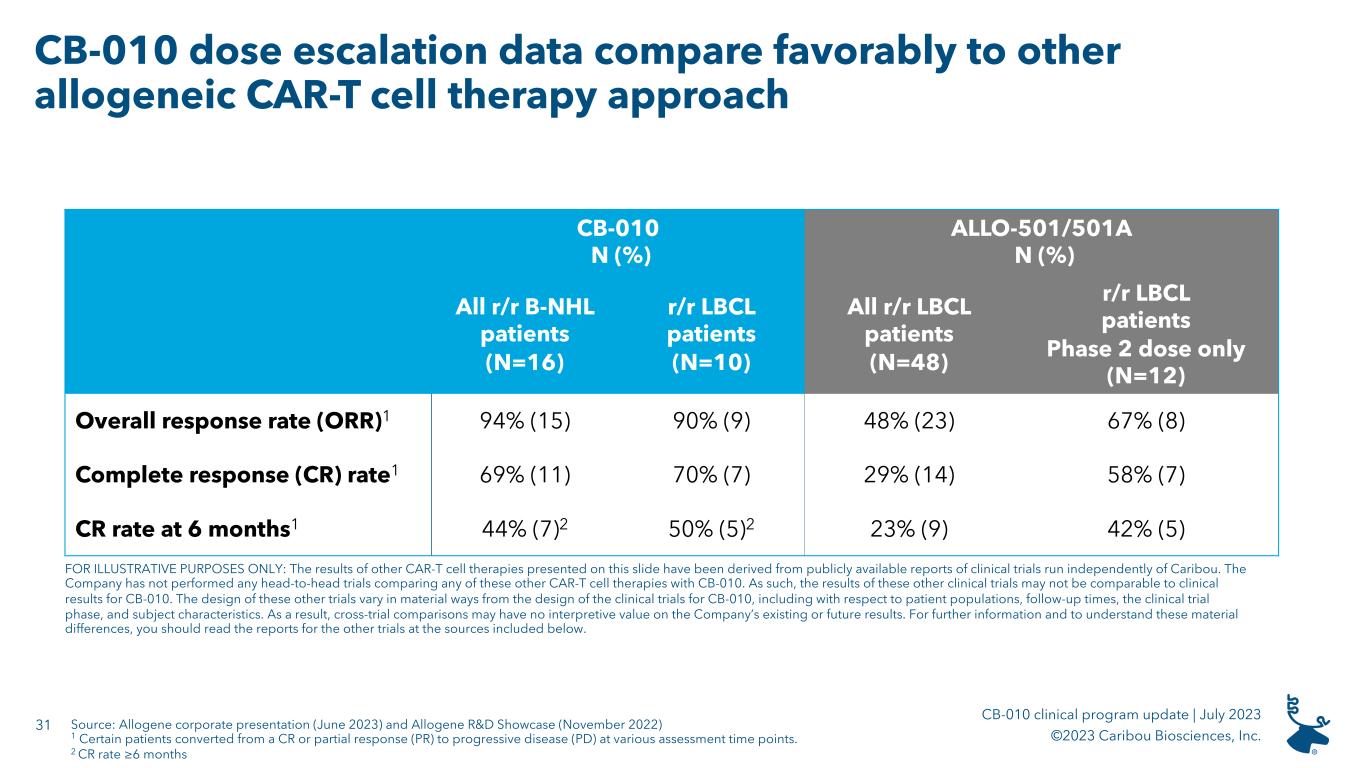
31 CB-010 clinical program update | July 2023 ©2023 Caribou Biosciences, Inc. CB-010 dose escalation data compare favorably to other allogeneic CAR-T cell therapy approach Source: Allogene corporate presentation (June 2023) and Allogene R&D Showcase (November 2022) 1 Certain patients converted from a CR or partial response (PR) to progressive disease (PD) at various assessment time points. 2 CR rate ≥6 months CB-010 N (%) ALLO-501/501A N (%) All r/r B-NHL patients (N=16) r/r LBCL patients (N=10) All r/r LBCL patients (N=48) r/r LBCL patients Phase 2 dose only (N=12) Overall response rate (ORR)1 94% (15) 90% (9) 48% (23) 67% (8) Complete response (CR) rate1 69% (11) 70% (7) 29% (14) 58% (7) CR rate at 6 months1 44% (7)2 50% (5)2 23% (9) 42% (5) FOR ILLUSTRATIVE PURPOSES ONLY: The results of other CAR-T cell therapies presented on this slide have been derived from publicly available reports of clinical trials run independently of Caribou. The Company has not performed any head-to-head trials comparing any of these other CAR-T cell therapies with CB-010. As such, the results of these other clinical trials may not be comparable to clinical results for CB-010. The design of these other trials vary in material ways from the design of the clinical trials for CB-010, including with respect to patient populations, follow-up times, the clinical trial phase, and subject characteristics. As a result, cross-trial comparisons may have no interpretive value on the Company’s existing or future results. For further information and to understand these material differences, you should read the reports for the other trials at the sources included below.
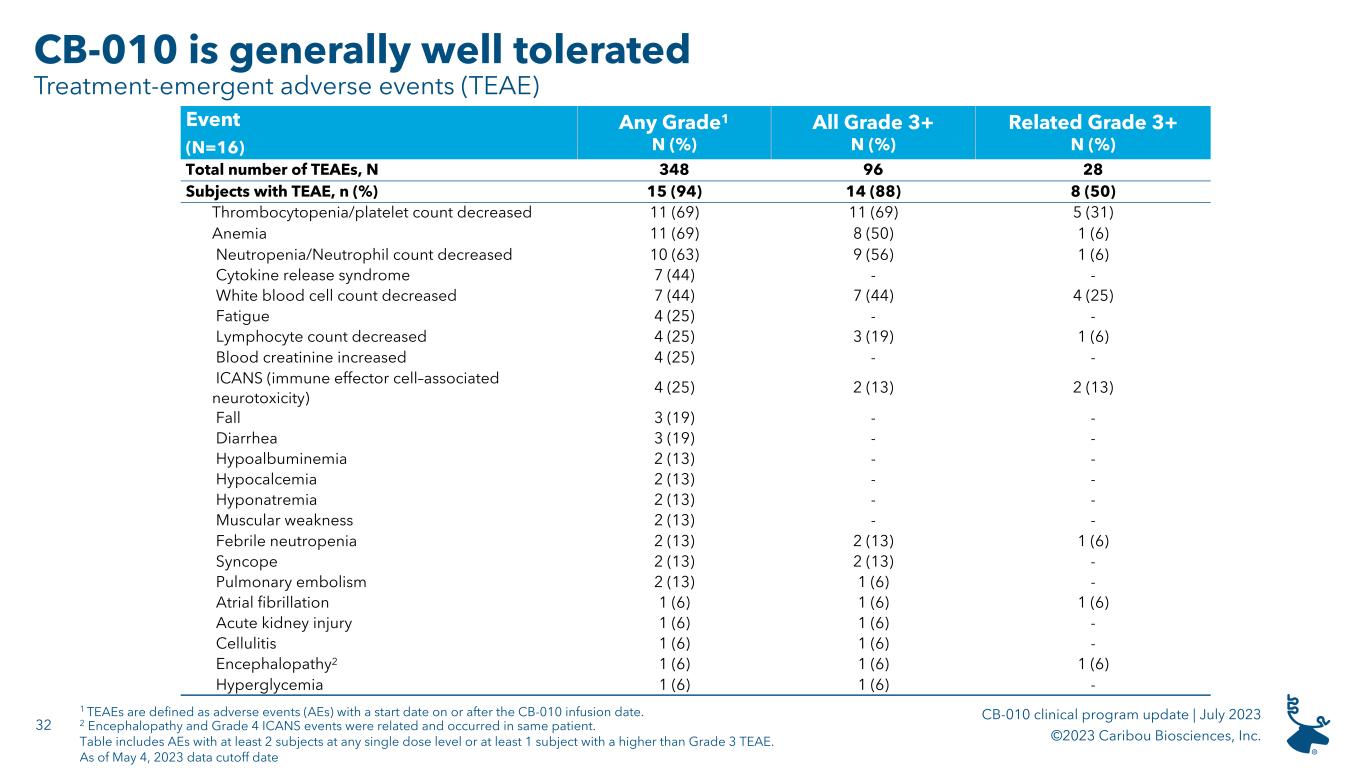
32 CB-010 clinical program update | July 2023 ©2023 Caribou Biosciences, Inc. CB-010 is generally well tolerated Treatment-emergent adverse events (TEAE) 1 TEAEs are defined as adverse events (AEs) with a start date on or after the CB-010 infusion date. 2 Encephalopathy and Grade 4 ICANS events were related and occurred in same patient. Table includes AEs with at least 2 subjects at any single dose level or at least 1 subject with a higher than Grade 3 TEAE. As of May 4, 2023 data cutoff date Event (N=16) Any Grade1 N (%) All Grade 3+ N (%) Related Grade 3+ N (%) Total number of TEAEs, N 348 96 28 Subjects with TEAE, n (%) 15 (94) 14 (88) 8 (50) Thrombocytopenia/platelet count decreased 11 (69) 11 (69) 5 (31) Anemia 11 (69) 8 (50) 1 (6) Neutropenia/Neutrophil count decreased 10 (63) 9 (56) 1 (6) Cytokine release syndrome 7 (44) - - White blood cell count decreased 7 (44) 7 (44) 4 (25) Fatigue 4 (25) - - Lymphocyte count decreased 4 (25) 3 (19) 1 (6) Blood creatinine increased 4 (25) - - ICANS (immune effector cell–associated neurotoxicity) 4 (25) 2 (13) 2 (13) Fall 3 (19) - - Diarrhea 3 (19) - - Hypoalbuminemia 2 (13) - - Hypocalcemia 2 (13) - - Hyponatremia 2 (13) - - Muscular weakness 2 (13) - - Febrile neutropenia 2 (13) 2 (13) 1 (6) Syncope 2 (13) 2 (13) - Pulmonary embolism 2 (13) 1 (6) - Atrial fibrillation 1 (6) 1 (6) 1 (6) Acute kidney injury 1 (6) 1 (6) - Cellulitis 1 (6) 1 (6) - Encephalopathy2 1 (6) 1 (6) 1 (6) Hyperglycemia 1 (6) 1 (6) -
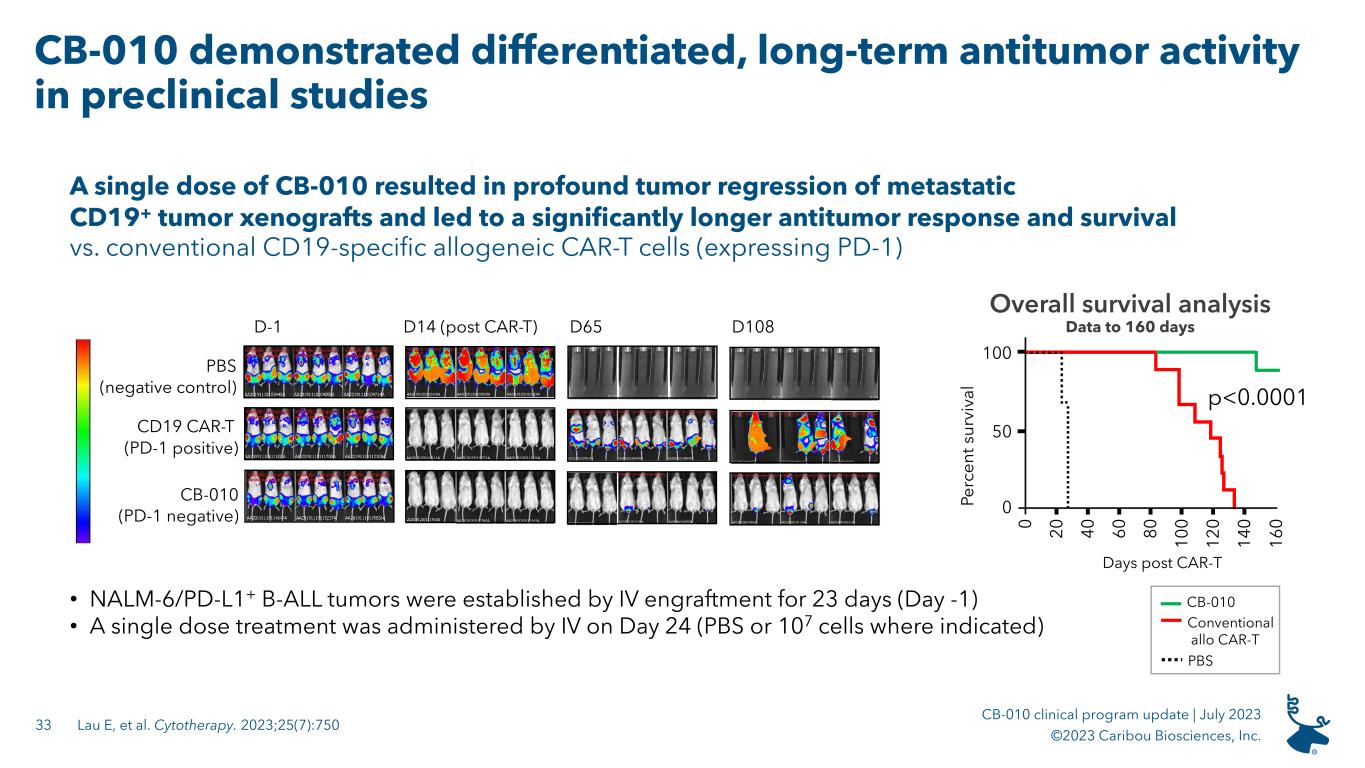
33 CB-010 clinical program update | July 2023 ©2023 Caribou Biosciences, Inc. CB-010 demonstrated differentiated, long-term antitumor activity in preclinical studies Lau E, et al. Cytotherapy. 2023;25(7):750 • NALM-6/PD-L1+ B-ALL tumors were established by IV engraftment for 23 days (Day -1) • A single dose treatment was administered by IV on Day 24 (PBS or 107 cells where indicated) A single dose of CB-010 resulted in profound tumor regression of metastatic CD19+ tumor xenografts and led to a significantly longer antitumor response and survival vs. conventional CD19-specific allogeneic CAR-T cells (expressing PD-1) Overall survival analysis Data to 160 days Days post CAR-T Pe rc en t s ur vi va l 100 50 0 p<0.0001 0 20 40 60 80 10 0 12 0 14 0 16 0 CB-010 Conventional allo CAR-T PBS PBS (negative control) CB-010 (PD-1 negative) D-1 D14 (post CAR-T) D65 D108 CD19 CAR-T (PD-1 positive)

34 CB-010 clinical program update | July 2023 ©2023 Caribou Biosciences, Inc. cGMP starting material Genetic modification via chRDNA and AAV Gene-modified CAR-T cells In vitro expansion of edited donor T cells Removal of residual TCR+ cells Final formulation & cryopreservation Treatment Anti-TCR microbeads Anti-CD19 CARTCR PD1 chRDNA Cas9 AAV Healthy donor leukapheresis TRAC PDCD1 Anti-CD19 CAR Chr 14 Chr 2 cGMP starting material Genetic m dification via chRDNA and AAV Gene-modified CAR-T cells In vitro expansion of edited donor T cells Removal of residual TCR+ ells Final formulation & cryopreservation Treatment Anti-TCR microbeads Anti-CD19 CARTCR PD1 chRDNA Cas9 AAV Healthy donor l ukapheresis TRAC PDCD1 Anti-CD19 CAR Chr 14 Chr 2 Allogeneic CAR-T cell manufacturing process overview for CB-010 Caribou’s process development team created the manufacturing process and transferred it to a CMO to generate phase 1 cGMP clinical material cGMP starting material Genetic modification via chRDNA and AAV Gene-modified CAR-T cells In vitro expansion of dited donor T cells Removal of residual TCR+ cells Final formulation & cryopreservationcGMP starting material Genetic modification via chRDNA and AAV Gene-modified CAR-T cells In vitro xpansion of edited donor T cells Removal of residual TCR+ cells Final formulation & cryopreservation Treatment Anti-TCR microbeads Anti-CD19 CARTCR PD1 chRDNA Cas9 AAV Healthy donor leukapheresis TRAC PDCD1 Anti-CD19 CAR Chr 14 Chr 2 cGMP starting material Genetic modification via chRDNA and AAV Gene-modified CAR-T cells In vitro expansion of edited donor T cells Removal of residual TCR+ cells Final formulation & cryopreservation Treatment Anti-TCR microbeads Anti-CD19 CARTCR PD1 chRDNA Cas9 AAV Healthy donor leukapheresis TRAC PDCD1 Anti-CD19 CAR Chr 14 Chr 2 Treatment cGMP starting material Genetic modification via chRDNA d AAV Gene-modified CAR-T cells In vitro expansion of edited donor T cells Removal of residual TCR+ cells Final formulation & cryopreservation Treatment Anti-TCR microbeads Anti-CD19 CARTCR PD1 chRDNA Cas9 AAV Healthy donor leukapheresis TRAC PDCD1 Anti-CD19 CAR Chr 14 Chr 2 cGMP starting material Genetic modification via chRDNA and AAV Gene-mo ified CAR-T cells In vitr expansion of edited donor T cells Removal of residual TCR+ cells Final formulation & cryopreservation Treatment Anti-TCR microbeads Anti-CD19 CARTCR PD1 chRDNA Cas9 AAV Healthy donor leukapheresis TRAC PDCD1 Anti-CD19 CAR Chr 14 Chr 2 cGMP starting material Genetic modification via chRDNA and AAV Gen -modified CAR-T cells In vitro xpansion of edited donor T cells Remov of residual TCR+ cells Fi al formulation & cryopreservati n Treatment Anti-TCR microbeads Anti-CD19 CARTCR PD1 chRDNA Cas9 AAV Healthy donor leukapheresis TRAC PDCD1 Anti-CD19 CAR Chr 14 Chr 2
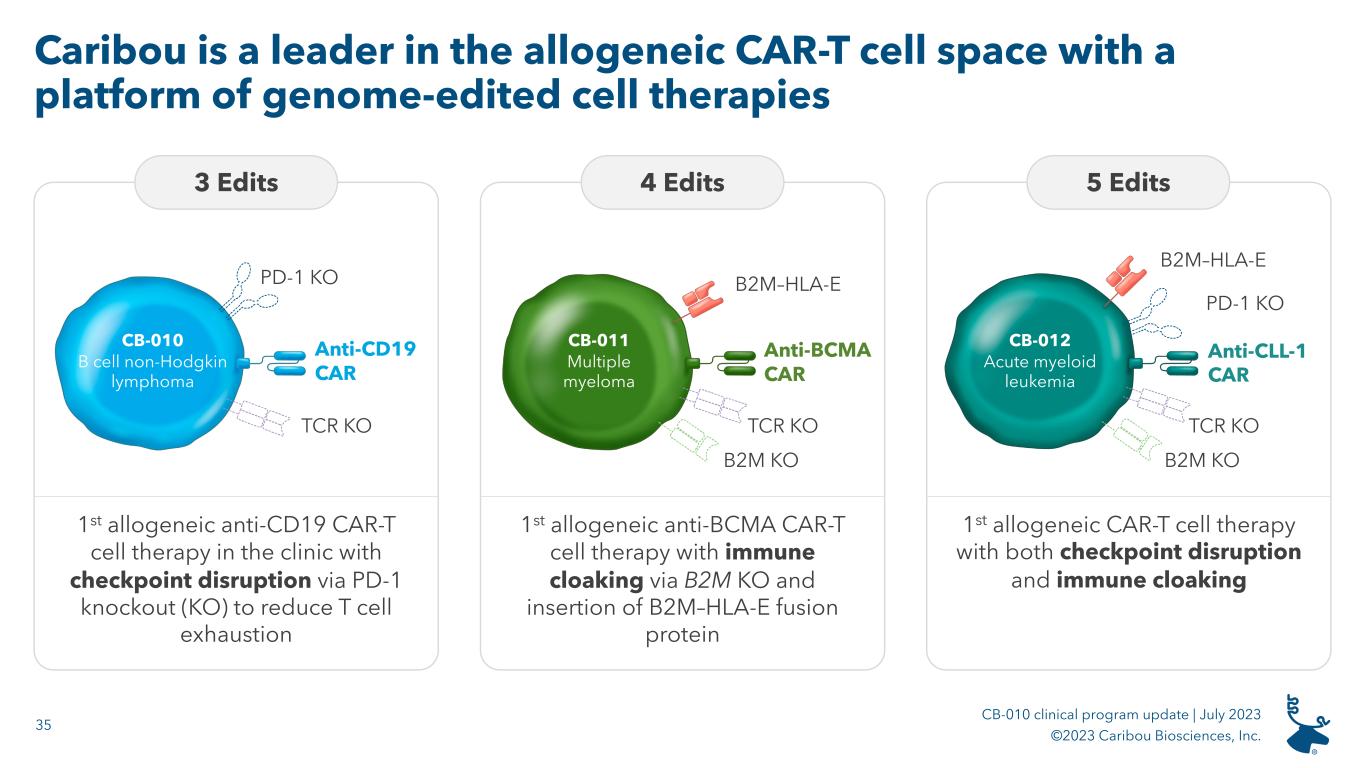
35 CB-010 clinical program update | July 2023 ©2023 Caribou Biosciences, Inc. Caribou is a leader in the allogeneic CAR-T cell space with a platform of genome-edited cell therapies 3 Edits 4 Edits 5 Edits CB-010 B cell non-Hodgkin lymphoma PD-1 KO Anti-CD19 CAR TCR KO CB-011 Multiple myeloma B2M–HLA-E Anti-BCMA CAR TCR KO B2M KO CB-012 Acute myeloid leukemia B2M–HLA-E Anti-CLL-1 CAR TCR KO B2M KO PD-1 KO 1st allogeneic anti-CD19 CAR-T cell therapy in the clinic with checkpoint disruption via PD-1 knockout (KO) to reduce T cell exhaustion 1st allogeneic anti-BCMA CAR-T cell therapy with immune cloaking via B2M KO and insertion of B2M–HLA-E fusion protein 1st allogeneic CAR-T cell therapy with both checkpoint disruption and immune cloaking
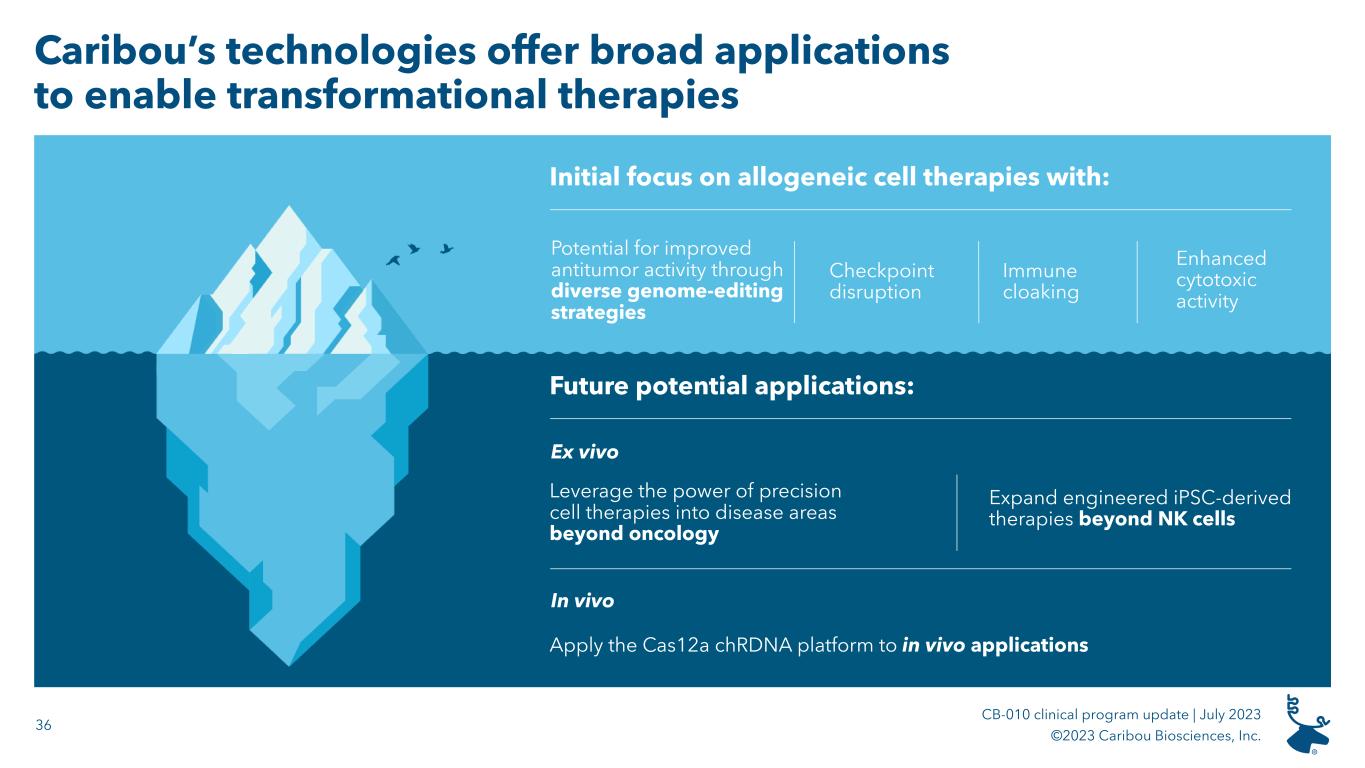
36 CB-010 clinical program update | July 2023 ©2023 Caribou Biosciences, Inc. Caribou’s technologies offer broad applications to enable transformational therapies Initial focus on allogeneic cell therapies with: Potential for improved antitumor activity through diverse genome-editing strategies Checkpoint disruption Immune cloaking Enhanced cytotoxic activity Future potential applications: Ex vivo Leverage the power of precision cell therapies into disease areas beyond oncology Expand engineered iPSC-derived therapies beyond NK cells In vivo Apply the Cas12a chRDNA platform to in vivo applications
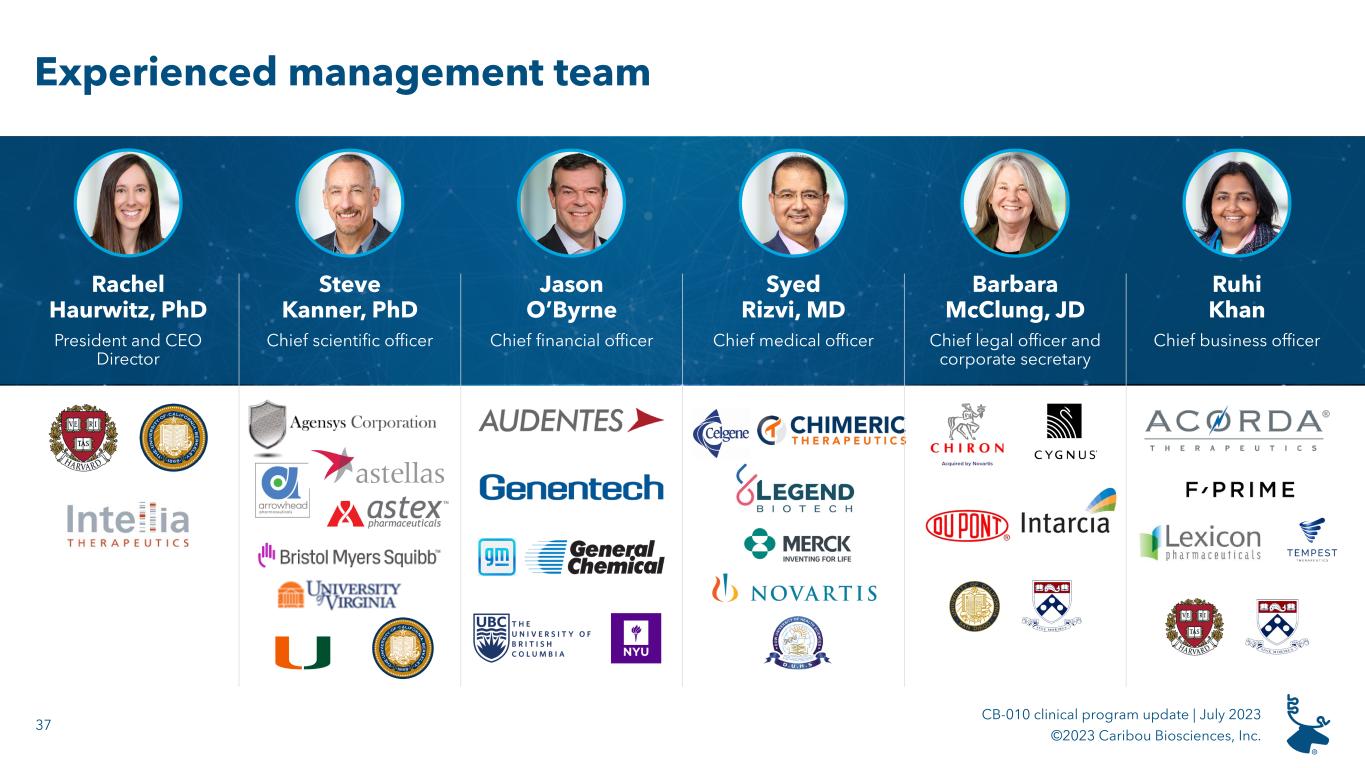
37 CB-010 clinical program update | July 2023 ©2023 Caribou Biosciences, Inc. Barbara McClung, JD Chief legal officer and corporate secretary Steve Kanner, PhD Chief scientific officer Jason O’Byrne Chief financial officer Rachel Haurwitz, PhD President and CEO Director Ruhi Khan Chief business officer Syed Rizvi, MD Chief medical officer Experienced management team




































